MQL5 中艾略特波浪自动分析的实施
简介
艾略特波浪理论是最流行的市场分析方法之一。然而,这个过程非常复杂,从而导致我们使用额外的工具。自动标记器是其中一种工具。
本文描述用 MQL5 语言创建艾略特波浪的自动分析程序。假定读者已经熟悉波浪理论;如果不熟悉,则需要参考适当的资料。
1. 艾略特波浪理论
艾略特波浪 - 市场行为的一种理论模型,由拉尔夫•.纳尔逊•.艾略特 (Ralph Nelson Elliott) 发明,依据该理论,市场中的所有价格变动受人的心理作用影响,是推动波到调整波以及调整波到推动波的一种循环变化过程。
推动波是一系列的五个价格波动,调整波是一系列的三个或五个价格波动。推动波在其形态、结构和适用的规则方面,具有以下类型:
| 1. 推动波: | |
|---|---|
 图 1. 推动波 |
|
| 2. 引导楔形波: | |
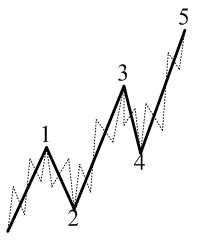 图 2. 引导楔形 |
|
| 3. 楔形波: | |
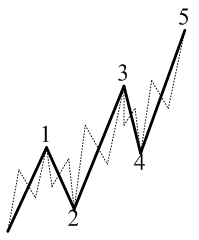 图 3. 楔形波 |
|
| 调整波归类为: | |
| 4. 锯齿: | |
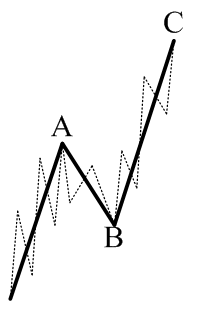 图 4. 锯齿波 |
|
| 5. 平顶波: | |
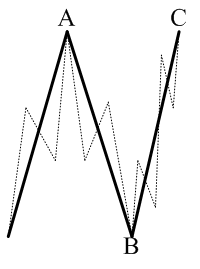 图 5. 平顶波 |
|
| 6. 双锯齿波: | |
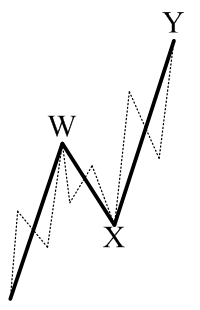 图 6. 双锯齿波 |
|
| 7. 三锯齿波: | |
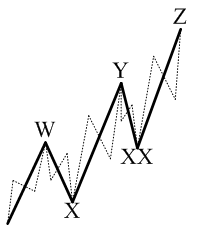 图 7. 三锯齿波 |
|
| 8. 双重三波: | |
 图 8. 双重三波 |
|
| 9. 三重三波: | |
 图 9. 三重三波 |
|
| 10. 收缩三角形波: | |
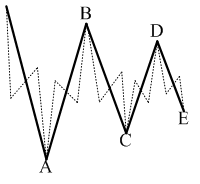 图 10. 收缩三角形波 |
|
| 11. 扩散三角形波: | |
 图 11. 扩散三角形波 |
|
以上描述的波浪模型和规则仅对应于波浪分析的经典概念。
还有在对 Forex 市场进行研究期间形成的现代概念。例如,建立了一种新的倾斜(滑动)三角形模型,识别出第二波中的带有三角形的推动波,等等。
如图 1-11 所示,每个推动波和调整波由若干相同但幅度较小的推动波和调整波(用虚线表示)构成。这就是所谓的艾略特波浪的分形(嵌套):大幅度的波浪由若干小幅度的波浪构成,小幅度的波浪又由更小幅度的波浪构成,依此类推。
通过这种说明,我们就完成了艾略特波浪理论的简短介绍,并能够前往波浪的自动标记这一主题。
2. 艾略特波浪的自动标记的算法
您或许已经意识到,艾略特波浪分析是一个复杂和多面的过程。因此,人们一开始就寻找和应用能够对其进行简化的工具。
其中一种工具成为艾略特波浪的自动标记的机制。
我们可以辨别自动标记的两个原则:
- 依据波浪的分形,从上到下,从大到小进行分析;
- 通过直接枚举所有可能的选项来进行分析。
图 12 说明了艾略特波浪自动分析的流程图。
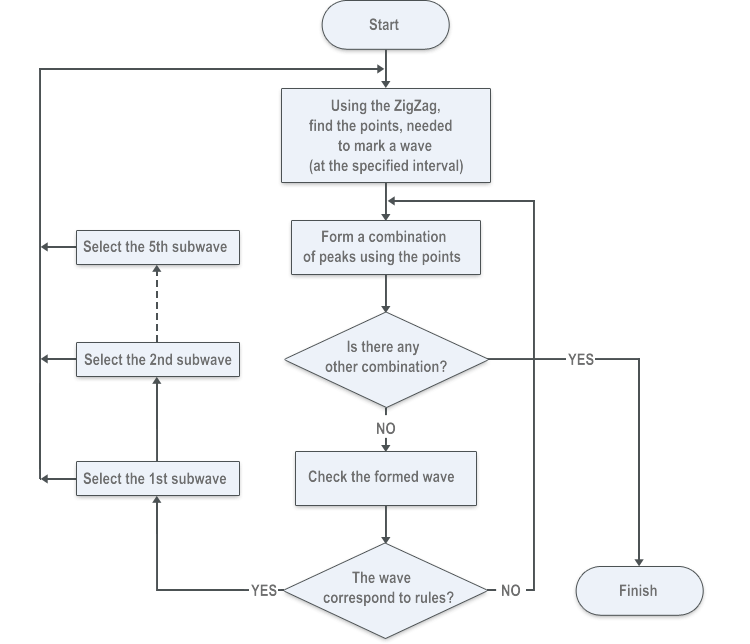
图 12. 艾略特波浪自动分析的流程图
依据推动波自动标记示例,更加详细地考虑算法(参见图 13)。
在第一阶段,在价格图需要的时间区间上,使用 "Zigzag"(锯齿),突出显示了进行标记所需的点数。点数取决于我们要分析哪类波浪。因此,要分析推动波,需要六个点 - 5 个顶点和一个起点。如果我们分析锯齿波,则需要的点数为 4 - 3 个顶点和一个起点。
如果 "Zigzag" 在价格图上找到了六个点,则我们可以立即生成一个推动波的标记:第一个点 - 第一波的起点,第二个点 - 第一波的顶点,第三个点 - 第二波的顶点,第四个点 - 第三波的顶点,第五个点 - 第四波的顶点,第六个点 - 第五波的顶点。
然而,在图 13 上,"Zigzag" 找出了 8 个点。在这种情况下,必须按这些点枚举所有可能的选项和波浪的标记。并且将有五个(以不同的颜色标记)。必须依据规则检查每一种标记。
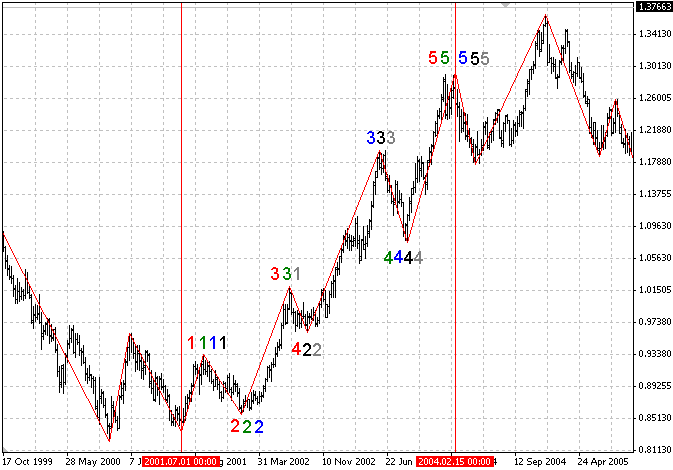
图 13. 推动波的标记选项
在依据规则进行检查之后,如果按照所有参数确定波浪的标志是推动波,则以相同的方式分析其全部子波浪。
所有其他推动波和调整波的分析都采用相同的方式。
3. 用于自动标记的波浪类型
如前文所述,分析将从上到下进行,指示程序在一定的区间内找出某些波浪。然而,在最大的区间内,不可能确定波浪的状态、起点与终点。我们将这种波浪称为未开始和未结束。
所有波浪都可分为以下组别:
- 未开始波浪:
- 具有未开始第一波的波浪 - 1-2-3-4-5(例如,一个具有未开始第 1 波的推动波,需要的点数 - 5),和 1-2-3(例如,具有未开始 A 波的锯齿波;需要的点数 - 3);
- 具有未开始第二波的波浪 - 2-3-4-5(例如,一个具有未开始第 2 波的楔形波,需要的点数 - 4),和 2-3(例如,具有未开始 B 波的平顶波;需要的点数 - 2);
- 具有未开始第三波的波浪 - 3-4-5(例如,一个具有未开始 Y 波的三重锯齿波;需要的点数 - 3);
- 具有未开始第四波的波浪 - 4-5(例如,一个具有未开始 D 波的三角形波;需要的点数 - 2);
- 具有未开始第五波的波浪 - 5(例如,一个具有未开始第 5 波的推动波;需要的点数 - 1);
- 具有未开始第三波的波浪 - 3(例如,一个具有未开始 Z 波的双重三波;需要的点数 - 1);
- 未结束波浪:
- 具有未结束第五波的波浪 - 1-2-3-4-5(例如,一个具有未结束第 5 波的推动波;需要的点数 - 5);
- 具有未结束第四波的波浪 - 1-2-3-4>(例如,一个具有未结束 XX 波的三重锯齿波;需要的点数 - 4);
- 具有未结束第三波的波浪 - 1-2-3>(例如,一个具有未结束第 3 波的引导楔形波;需要的点数 - 3);
- 具有未结束第二波的波浪 - 1-2>(例如,一个具有未结束 B 波的锯齿波;需要的点数 - 2);
- 具有未结束第一波的波浪 - 1>(例如,一个具有未结束 A 波的平顶波;需要的点数 - 1);
- 未开始和未结束波浪:
- 具有未开始第一波和未结束第二波的波浪 - 1-2>(例如,一个具有未开始 A 波和未结束 B 波的锯齿波;需要的点数 - 1);
- 具有未开始第二波和未结束第三波的波浪 - 2-3>(例如,一个具有未开始 B 波和未结束 C 波的锯齿波;需要的点数 - 1);
- 具有未开始第三波和未结束第四波的波浪 - 3-4><(例如,一个具有未开始第 3 波和未结束第 4 波的推动波;需要的点数 - 1);
- 具有未开始第四波和未结束第五波的波浪 - 4-5>(例如,一个具有未开始第 4 波和未结束第 5 波的推动波;需要的点数 - 1);
- 具有未开始第一波和未结束第三波的波浪 - 1-2-3>(例如,一个具有未开始 W 波和未结束 Y 波的三重三波;需要的点数 - 2);
- 具有未开始第二波和未结束第四波的波浪 - 2-3-4>(例如,一个具有未开始第 2 波和未结束第 4 波的引导楔形波;需要的点数 - 2);
- 具有未开始第三波和未结束第五波的波浪 - 3-4-5>(例如,一个具有未开始第 3 波和未结束第 5 波的楔形波;需要的点数 - 2);
- 具有未开始第一波和未结束第四波的波浪 - 1-2-3-4>(例如,一个具有未开始 W 波和未结束 XX 波的三重三波;需要的点数 - 3);
- 具有未开始第二波和未结束第五波的波浪 - 2-3-4-5(例如,一个具有未开始第 2 波和未结束第 5 波的推动波;需要的点数 - 3);
- 具有未开始第一波和未结束第五波的波浪 - 1-2-3-4-5>(例如,一个具有未开始 W 波和未结束 Z 波的三重三波;需要的点数 - 4);
- 已完成波浪 - 1-2-3-4-5(需要的点数 - 6)和 1-2-3(需要的点数 - 4)。
波浪编号后面的符号 "<" 表示未开始。波浪编号后面的符号 ">" 表示未结束。
在图 14 中,我们可以看到下波浪:
- 一个具有未开始第一波 A 的波浪 -A -B-C;
- 一个具有未开始第一个 W 和未结束第二个 X 波浪的波浪 -W<-X>;
- 已完成波浪 B 和 C;
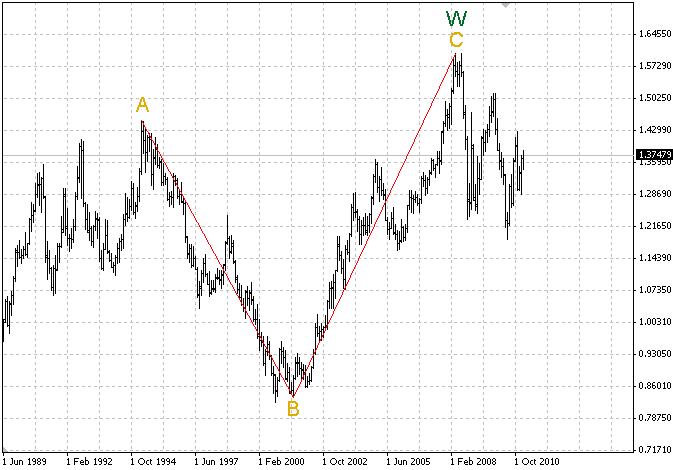
图 14. 未开始和未结束波浪
4. 艾略特波浪自动分析程序的数据结构说明
要编写艾略特波浪的自动分析程序,我们需要以下数据结构:
4.1. 用于在程序中描述所分析的波浪的结构:
// The structure of the description of the analyzed waves in the program struct TWaveDescription { string NameWave; // name of the wave int NumWave; // number of sub-waves in a wave string Subwaves[6]; // the names of the possible sub-waves in the wave };
4.2. 用于存储具体波浪的参数的类:
// A class for storing the parameters of a wave class TWave { public: string Name; // name of the wave string Formula; // the formula of the wave (1-2-3-4-5, <1-2-3 etc.) int Level; // the level of the wave double ValueVertex[6]; // the value of the top of the wave int IndexVertex[6]; // the indexes of the top of the waves };
4.3. 用于存储锯齿波的顶点的顶点值和顶点索引的类:
// A class for storing the values of vertexes and indexes of the zigzag class TZigzag:public CObject { public: CArrayInt *IndexVertex; // indexes of the vertexes of the zigzag CArrayDouble *ValueVertex; // value of the vertexes of the zigzags };
4.4. 用于表示波浪树的类:
// A class for the presentation of the tree of the waves class TNode:public CObject { public: CArrayObj *Child; // the child of the given tree node TWave *Wave; // the wave, stored in the given tree node string Text; // text of the tree node TNode *Add(string Text,TWave *Wave=NULL) // the function of adding the node to the tree { TNode *Node=new TNode; Node.Child=new CArrayObj; Node.Text =Text; Node.Wave=Wave; Child.Add(Node); return(Node); } };
4.5. 用于存储锯齿波找到的点的结构:
// The structure for storing the points, found by the zigzag struct TPoints { double ValuePoints[]; // the values of the found points int IndexPoints[]; // the indexes of the found points int NumPoints; // the number of found points };
4.6. 用于存储已经分析过的图表部分的参数的类:
// A class for storing the parameters of the already analyzed section, corresponding to the wave tree node class TNodeInfo:CObject { public: int IndexStart,IndexFinish; // the range of the already analyzed section double ValueStart,ValueFinish; // the edge value of the already analyzed section string Subwaves; // the name of the wave and the group of the waves TNode *Node; // the node, pointing to the already analyzed range of the chart };
4.7. 用于在将其放在图表上之前存储波浪标记的类:
// A class for storing the marking of waves before placing them on the chart class TLabel:public CObject { public: double Value; // the value of the vertex int Level; // the level of the wave string Text; // the marking of the wave };
5. 艾略特波浪自动分析程序的函数说明
要编写艾略特波浪的自动分析程序,我们需要以下函数:
int Zigzag(intH,int Start,int Finish,CArrayInt *IndexVertex,CArrayDouble *ValueVertex)
艾略特波浪的自动分析程序中的一个关键元素是依据其建立波浪的 “锯齿波”(Zigzag)。依据任何参数进行的“锯齿波”计算必须非常快速地完成。
在我们的分析程序中,我们将使用“如何编写快速非重绘锯齿波”一文描述的“锯齿波”。
Zigzag 函数在从 Start(开始)到 Finish(结束)的时间区间内使用参数 H 计算锯齿波,然后将找到的顶点索引和顶点值分别记录到数组 IndexVertex 和 ValueVertex 中,这些数组的地址被传递到该函数。
Zigzag 函数返回找到的“锯齿波”顶点的数量。
填充“锯齿”并存储其参数的函数:
void FillZigzagArray(int Start,int Finish)
如前文所述,我们需要在价格图表中找到必需数量的点才能标记波浪。因此,我们需要有一个具有不同参数的“锯齿波”顶点数组,之后我们将迭代该数组以找出这些点。
FillZigzagArray 函数从 Start(开始)到 Finish(结束)用参数 H 的所有可能值计算图表区间上的“锯齿波”(直到“锯齿波”的顶点数量不等于或小于 2),将找到顶点的相关信息存储在 TZigzag 类的对象中,并且将这些对象记录到全局数组 ZigzagArray 中,该全局数组的声明如下所示:
CArrayObj *ZigzagArray;
在指定区间运行的搜索函数需要在价格图上有若干点:
bool FindPoints(int NumPoints,int IndexStart,int IndexFinish,double ValueStart,double ValueFinish,TPoints &Points)
函数 FindPoints 在需要的范围内,从 IndexStart 至 IndexFinish,使用所要求的第一个点和最后一个点的值(ValueStart 和 ValueFinish),在价格图上搜索至少三个 NumPoints 点,并将它们(即点)保存到结构 Points 中,该结构的链接被传递给该函数。
如果找到所需数量的点,则函数 FindPoints 返回 true,否则返回 false。
5.4. NotStartedAndNotFinishedWaves
未开始和未结束波浪的分析函数:
void NotStartedAndNotFinishedWaves(TWave *ParentWave,int NumWave,TNode *Node,string Subwaves,int Level)
函数 NotStartedAndNotFinishedWaves 分析第三组波浪(未开始波浪和未结束波浪)的所有波浪。函数分析第 NumWave 波(波浪级别为 Level)、名为 ParentWave.Name 的波浪,可以是子波浪的形态(锯齿、平顶、双锯齿等形态)。经过分析的第 NumWave 波将存储在波浪树的节点中,子节点 Node。
例如,如果 ParentWave.Name = "Impulse",NumWave = 5,Subwaves = "Impulse, Diagonal",Level = 2,则我们可以说 NotStartedAndNotFinishedWaves 函数将分析推动波的第五波,该波的波浪级别为 2,并且可以是推动波或楔形波。
我们使用 NotStartedAndNotFinishedWaves 函数中的未开始和未结束波浪 1<-2-3> 的算法分析流程图作为一个例子:
<img alt="图 15. 形态 "1" 的波浪分析流程图" title="图 15. 形态 "1" 的波浪分析流程图" src="http://p.mql5.com/data/2/260/fig15.gif" style="vertical-align:middle;" height="1746" width="750">
图 15. 形态 "1<-2-3>" 的波浪分析流程图
在使用 NotStartedAndNotFinishedWaves 函数时,调用了以下函数:NotStartedWaves、NotFinishedWaves 和 FinishedWaves。
用于分析未开始波浪的函数:
void NotStartedWaves(TWave *ParentWave,int NumWave,TNode *Node,string Subwaves,int Level)
函数 NotStartedWaves 分析第一组波浪(未开始波浪)的所有波浪。函数分析名为 ParentWave.Name 的波浪的第 NumWave 波(波浪级别为 Level),可以是子波浪的形态。经过分析的第 NumWave 波将存储在波浪树的节点中,子节点 Node。
在 NotStartedWaves 函数运行期间,调用了以下函数:NotStartedWaves 和 FinishedWaves。
以类似于图 15 中的流程图的方式分析所有波浪。
用于分析未结束波浪的函数:
void NotFinishedWaves(TWave *ParentWave,int NumWave,TNode *Node,string Subwaves,int Level)
函数 NotFinishedWaves 分析第二组波浪(未结束波浪)的所有波浪。函数分析名为 ParentWave.Name 的波浪的第 NumWave 波(波浪级别为 Level),可以是子波浪的形态。经过分析的第 NumWave 波将存储在波浪树的节点中,子节点 Node。
在 NotFinishedWaves 函数运行期间,调用了以下函数:NotFinishedWaves 和 FinishedWaves。
以类似于图 15 中的流程图的方式分析所有波浪。
用于分析已完成(已结束)波浪的函数:
void FinishedWaves(TWave *ParentWave,int NumWave,TNode *Node,string Subwaves,int Level)
函数 FinishedWaves 分析第四组波浪(已完成波浪)的所有波浪。函数分析名为 ParentWave.Name 的波浪的第 NumWave 波(波浪级别为 Level),可以是子波浪的形态。经过分析的第 NumWave 波将存储在波浪树的节点中,子节点 Node。
在 FinishedWaves 函数运行期间,调用了函数 FinishedWaves。
以类似于图 15 中的流程图的方式分析所有波浪。
5.8. FindWaveInWaveDescription
在数据结构 WaveDescription 中搜索波浪的函数:
int FindWaveInWaveDescription(string NameWave)
函数 FindWaveInWaveDescription 按照作为一个参数传递的波浪名称 NameWave,在 WaveDescription 结构数组中搜索波浪,并返回对应于该波浪的索引号。
WaveDescription 结构数组看起来如下所示:
TWaveDescription WaveDescription[]= { { "Impulse",5, { "", "Impulse,Leading Diagonal,", "Zigzag,Flat,Double Zigzag,Triple Zigzag,Double Three,Triple Three,", "Impulse,", "Zigzag,Flat,Double Zigzag,Triple Zigzag,Double Three,Triple Three,Contracting Triangle,Expanding Triangle,", "Impulse,Diagonal," } } , { "Leading Diagonal",5, { "", "Impulse,Leading Diagonal,", "Zigzag,Flat,Double Zigzag,Triple Zigzag,Double Three,Triple Three,", "Impulse,", "Zigzag,Flat,Double Zigzag,Triple Zigzag,Double Three,Triple Three,Contracting Triangle,Expanding Triangle,", "Impulse,Diagonal," } } , { "Diagonal",5, { "", "Zigzag,Flat,Double Zigzag,Triple Zigzag,Double Three,Triple Three,", "Zigzag,Flat,Double Zigzag,Triple Zigzag,Double Three,Triple Three,", "Zigzag,Flat,Double Zigzag,Triple Zigzag,Double Three,Triple Three,", "Zigzag,Flat,Double Zigzag,Triple Zigzag,Double Three,Triple Three,Contracting Triangle,Expanding Triangle,", "Zigzag,Flat,Double Zigzag,Triple Zigzag,Double Three,Triple Three,Contracting Triangle,Expanding Triangle," } } , { "Zigzag",3, { "", "Impulse,Leading Diagonal,", "Zigzag,Flat,Double Zigzag,Triple Zigzag,Double Three,Triple Three,Contracting Triangle,Expanding Triangle,", "Impulse,Diagonal,", "", "" } } , { "Flat",3, { "", "Zigzag,Flat,Double Zigzag,Triple Zigzag,Double Three,Triple Three,", "Zigzag,Flat,Double Zigzag,Triple Zigzag,Double Three,Triple Three,Contracting Triangle,Expanding Triangle,", "Impulse,Diagonal,", "", "" } } , { "Double Zigzag",3, { "", "Zigzag,", "Zigzag,Flat,Double Zigzag,Triple Zigzag,Double Three,Triple Three,Contracting Triangle,Expanding Triangle,", "Zigzag,", "", "" } } , { "Triple Zigzag",5, { "", "Zigzag,", "Zigzag,Flat,Double Zigzag,Triple Zigzag,Double Three,Triple Three,", "Zigzag,", "Zigzag,Flat,Double Zigzag,Triple Zigzag,Triple Three,Contracting Triangle,Expanding Triangle,", "Zigzag," } } , { "Double Three",3, { "", "Zigzag,Flat,Double Zigzag,Triple Zigzag,Double Three,Triple Three,", "Zigzag,Flat,Double Zigzag,Triple Zigzag,Double Three,Triple Three,Contracting Triangle,Expanding Triangle,", "Zigzag,Flat,Double Zigzag,Triple Zigzag,Double Three,Triple Three,Contracting Triangle,Expanding Triangle,", "", "" } } , { "Triple Three",5, { "", "Zigzag,Flat,Double Zigzag,Triple Zigzag,Double Three,Triple Three,", "Zigzag,Flat,Double Zigzag,Triple Zigzag,Double Three,Triple Three,", "Zigzag,Flat,Double Zigzag,Triple Zigzag,Double Three,Triple Three,", "Zigzag,Flat,Double Zigzag,Triple Zigzag,Double Three,Triple Three,Contracting Triangle,Expanding Triangle,", "Zigzag,Flat,Double Zigzag,Triple Zigzag,Double Three,Triple Three,Contracting Triangle,Expanding Triangle," } } , { "Contracting Triangle",5, { "", "Zigzag,Flat,Double Zigzag,Triple Zigzag,Double Three,Triple Three,", "Zigzag,Flat,Double Zigzag,Triple Zigzag,Double Three,Triple Three,", "Zigzag,Flat,Double Zigzag,Triple Zigzag,Double Three,Triple Three,", "Zigzag,Flat,Double Zigzag,Triple Zigzag,Double Three,Triple Three,Contracting Triangle,Expanding Triangle,", "Zigzag,Flat,Double Zigzag,Triple Zigzag,Double Three,Triple Three,Contracting Triangle,Expanding Triangle," } } , { "Expanding Triangle",5, { "", "Zigzag,Flat,Double Zigzag,Triple Zigzag,Double Three,Triple Three,", "Zigzag,Flat,Double Zigzag,Triple Zigzag,Double Three,Triple Three,", "Zigzag,Flat,Double Zigzag,Triple Zigzag,Double Three,Triple Three,", "Zigzag,Flat,Double Zigzag,Triple Zigzag,Double Three,Triple Three,Contracting Triangle,Expanding Triangle,", "Zigzag,Flat,Double Zigzag,Triple Zigzag,Double Three,Triple Three,Contracting Triangle,Expanding Triangle," } } }; 函数 FindWaveInWaveDescription 在分析以下波浪的函数中使用:NotStartedAndNotFinishedWaves、NotStartedWaves、NotFinishedWaves 和 FinishedWaves。
用于检查已经分析了指定图表部分的函数:
bool Already(TWave *Wave,int NumWave,TNode *Node,string Subwaves)
因为艾略特波浪的自动分析采用枚举法,可能会出现已经针对一个波浪或一组波浪的存在分析了指定图表部分的情形。要知道这种情形,需要将节点的链接保存到已经分析过的波浪的波浪树中,之后才输出链接。所有这些都发生在函数 Already 中。
函数 Already 查找全局数组 NodeInfoArray,该数组存储 TNodeInfo 类的对象、图表区间,对应于第 NumWave 波,名为 Wave.Name,具有子波浪的形态,并且将图表中已经标记的部分的节点的地址记录到 Node 中。如果此部分不存在,则创建并填写一个 TNodeInfo 类的新对象,并且记录到 NodeInfoArray 数组中。
如果已经分析了图表的区间,则函数返回 true,否则返回 false。
按以下方式声明 NodeInfoArray 数组:
CArrayObj NodeInfoArray;
5.10. 按规则检查波浪的函数
它包括函数 VertexAAboveB、WaveAMoreWaveB 和 WaveRules(从这个函数调用前两个函数)。在测试时请记住,波浪可以是未开始和(或)未结束的,例如对于具有形态 "1<-2-3>" 的波浪,无法确定第四波是否超过第一波的范围,因为尚不存在第四波。
按规则检查波浪的函数:
bool WaveRules(TWave *Wave) 如果名为 Wave.Name 的波浪是“正确”的,则函数 WaveRules 返回 true,否则返回 false。在其运行期间,函数 WaveRules 被函数 VertexAAboveVertexB 和 WaveAMoreWaveB 调用。
检查一个顶点是否超过另一个顶点的函数:
int VertexAAboveVertexB(int A,int B,bool InternalPoints)
如果 A 波的顶点超过 B 波的顶点,则函数 VertexAAboveVertexB 返回一个 > = 0 的数字,否则返回 -1。如果 InternalPoints = true,则考虑波浪的内部点(波浪的最高值和(或)最低值)。
检查一个波浪的长度是否超过另一个波浪的长度的函数:
int WaveAMoreWaveB(int A,int B)
如果 A 波长于 B 波,则函数 WaveAMoreWaveB 返回一个 >=0 的数字,否则返回-1。
11. 清除内存的函数
清除具有顶部节点 Node 的波浪树的函数:
void ClearTree(TNode *Node) 清除数组 ClearNodeInfoArray 的函数:
void ClearNodeInfoArray() 清除数组 ZigzagArray 的函数:
void ClearZigzagArray() 5.12. 绕过波浪树并将分析结果发送到图表的函数
完成艾略特波浪的自动分析之后,我们得到一个波浪树。
其例子如下图所示:
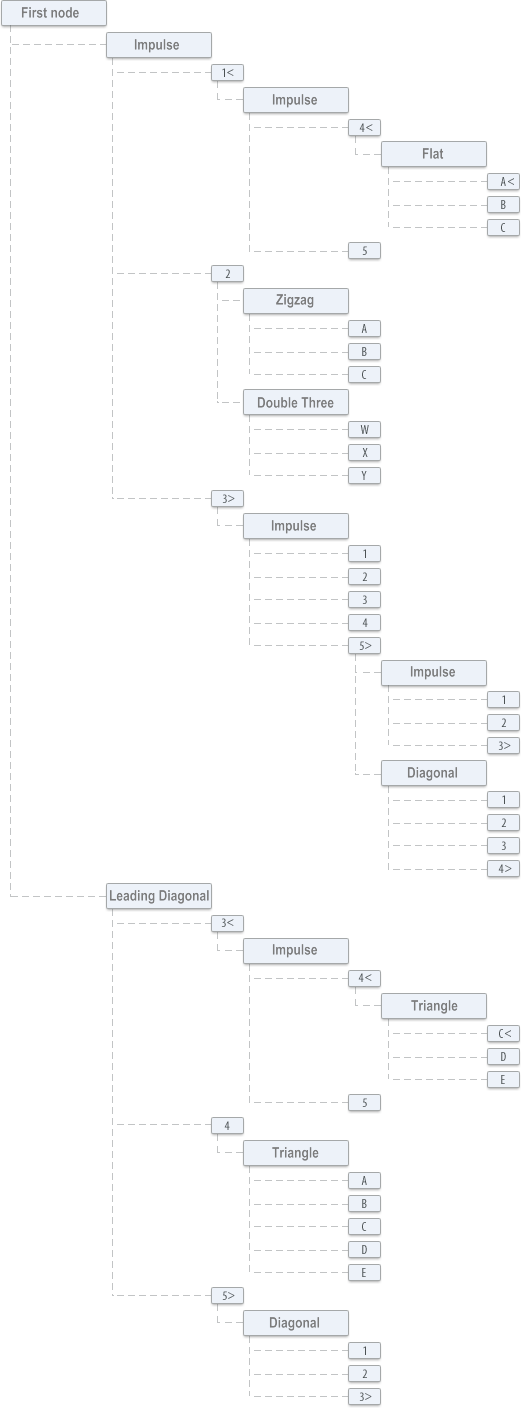
图 16. 波浪树的一个例子
现在,为了在图表上显示分析结果,我们需要绕过指定的树。如图 16 所示,有相当多的选项(因为有几个波浪选项),并且绕过的每个选项导致不同的标记。
我们可以区分两类树节点。
第一类 - 含有波浪名称的节点("Impulse"、"Zigzag" 等)。第二类 - 含有波浪编号的节点("1"、"1<" 等)。有关波浪参数的所有信息都存储在第一类节点中。因此,当访问这些节点时,为了在图表上显示波浪,我们需要获取和记录有关波浪的信息。
为了简单起见,我们将绕过波浪树,仅访问波浪的第一类型。
图 17 显示了一个绕过波浪树的例子,并且以红色突出显示。

图 17. 绕过波浪树的例子
绕过波浪树的例子:
void FillLabelArray(TNode *Node) 函数 FillLabelArray 绕过具有根节点的波浪树,仅注意树中波浪的第一类型,并用图表上的指定索引填充全局数组 LabelArray,该数组的索引存储到顶点数组的链接(TLabel 类的对象数组)。
数组 LabelArray 的定义如下:
CArrayObj *LabelArray[];
在图表上显示分析结果的函数:
void CreateLabels() 函数 CreateLabels 对应于图表上的波浪标记创建图形对象 "Text"。波浪标记是依据数组 LabelArray 创建的。
在图表上(纠正)波浪顶部的更新函数:
void CorrectLabel() 函数 CorrectLabel 在图表滚动时或在其限制期间纠正图表上的波浪标记。
6. 艾略特波浪的自动划分的实施
//+------------------------------------------------------------------+ //| The Zigzag function | //+------------------------------------------------------------------+ int Zigzag(int H,int Start,int Finish,CArrayInt *IndexVertex,CArrayDouble *ValueVertex) { bool Up=true; double dH=H*Point(); int j=0; int TempMaxBar = Start; int TempMinBar = Start; double TempMax = rates[Start].high; double TempMin = rates[Start].low; for(int i=Start+1;i<=Finish;i++) { // processing the case of a rising segment if(Up==true) { // check that the current maximum has not changed if(rates[i].high>TempMax) { // if it has, correct the corresponding variables TempMax=rates[i].high; TempMaxBar=i; } else if(rates[i].low<TempMax-dH) { // otherwise, if the lagged level is broken, fixate the maximum ValueVertex.Add(TempMax); IndexVertex.Add(TempMaxBar); j++; // correct the corresponding variables Up=false; TempMin=rates[i].low; TempMinBar=i; } } else { // processing the case of the descending segment // check that the current minimum hasn't changed if(rates[i].low<TempMin) { // if it has, correct the corresponding variables TempMin=rates[i].low; TempMinBar=i; } else if(rates[i].high>TempMin+dH) { // otherwise, if the lagged level is broken, fix the minimum ValueVertex.Add(TempMin); IndexVertex.Add(TempMinBar); j++; // correct the corresponding variables Up=true; TempMax=rates[i].high; TempMaxBar=i; } } } // return the number of zigzag tops return(j); }
CArrayObj *ZigzagArray; // declare the ZigzagArray global dynamic array //+------------------------------------------------------------------+ //| The FillZigzagArray function | //| search through the values of the parameter H zigzag | //| and fill the array ZigzagArray | //+------------------------------------------------------------------+ void FillZigzagArray(int Start,int Finish) { ZigzagArray=new CArrayObj; // create the dynamic array of zigzags CArrayInt *IndexVertex=new CArrayInt; // create the dynamic array of indexes of zigzag tops CArrayDouble *ValueVertex=new CArrayDouble; // create the dynamic array of values of the zigzag tops TZigzag *Zigzag; // declare the class for storing the indexes and values of the zigzag tops int H=1; int j=0; int n=Zigzag(H,Start,Finish,IndexVertex,ValueVertex);//find the tops of the zigzag with the parameter H=1 if(n>0) { // store the tops of the zigzag in the array ZigzagArray Zigzag=new TZigzag; // create the object for storing the found indexes and the zigzag tops, // fill it and store in the array ZigzagArray Zigzag.IndexVertex=IndexVertex; Zigzag.ValueVertex=ValueVertex; ZigzagArray.Add(Zigzag); j++; } H++; // loop of the H of the zigzag while(true) { IndexVertex=new CArrayInt; // create a dynamic array of indexes of zigzag tops ValueVertex=new CArrayDouble; // create a dynamic array of values of the zigzag tops n=Zigzag(H,Start,Finish,IndexVertex,ValueVertex); // find the tops of the zigzag if(n>0) { Zigzag=ZigzagArray.At(j-1); CArrayInt *PrevIndexVertex=Zigzag.IndexVertex; // get the array of indexes of the previous zigzag bool b=false; // check if there is a difference between the current zigzag and the previous zigzag for(int i=0; i<=n-1;i++) { if(PrevIndexVertex.At(i)!=IndexVertex.At(i)) { // if there is a difference, store the tops of a zigzag in the array ZigzagArray Zigzag=new TZigzag; Zigzag.IndexVertex=IndexVertex; Zigzag.ValueVertex=ValueVertex; ZigzagArray.Add(Zigzag); j++; b=true; break; } } if(b==false) { // otherwise, if there is no difference, release the memory delete IndexVertex; delete ValueVertex; } } // search for the tops of the zigzag until there is two or less of them if(n<=2) break; H++; } }
//+------------------------------------------------------------------+ //| The FindPoints function | //| Fill the ValuePoints and IndexPoints arrays | //| of the Points structure | //+------------------------------------------------------------------+ bool FindPoints(int NumPoints,int IndexStart,int IndexFinish,double ValueStart,double ValueFinish,TPoints &Points) { int n=0; // fill the array ZigzagArray for(int i=ZigzagArray.Total()-1; i>=0;i--) { TZigzag *Zigzag=ZigzagArray.At(i); // the obtained i zigzag in the ZigzagArray CArrayInt *IndexVertex=Zigzag.IndexVertex; // get the array of the indexes of the tops of the i zigzags CArrayDouble *ValueVertex=Zigzag.ValueVertex; // get the array of values of the tops of the i zigzag int Index1=-1,Index2=-1; // search the index of the IndexVertex array, corresponding to the first point for(int j=0;j<IndexVertex.Total();j++) { if(IndexVertex.At(j)>=IndexStart) { Index1=j; break; } } // search the index of the IndexVertex array, corresponding to the last point for(int j=IndexVertex.Total()-1;j>=0;j--) { if(IndexVertex.At(j)<=IndexFinish) { Index2=j; break; } } // if the first and last points were found if((Index1!=-1) && (Index2!=-1)) { n=Index2-Index1+1; // find out how many points were found } // if the required number of points was found (equal or greater) if(n>=NumPoints) { // check that the first and last tops correspond with the required top values if(((ValueStart!=0) && (ValueVertex.At(Index1)!=ValueStart)) || ((ValueFinish!=0) && (ValueVertex.At(Index1+n-1)!=ValueFinish)))continue; // fill the Points structure, passed as a parameter Points.NumPoints=n; ArrayResize(Points.ValuePoints, n); ArrayResize(Points.IndexPoints, n); int k=0; // fill the ValuePoints and IndexPoints arrays of Points structure for(int j=Index1; j<Index1+n;j++) { Points.ValuePoints[k]=ValueVertex.At(j); Points.IndexPoints[k]=IndexVertex.At(j); k++; } return(true); }; }; return(false); };
6.4. NotStartedAndNotFinishedWaves 函数:
//+------------------------------------------------------------------+ //| The NotStartedAndNotFinishedWaves function | //+------------------------------------------------------------------+ void NotStartedAndNotFinishedWaves(TWave *ParentWave,int NumWave,TNode *Node,string Subwaves,int Level) { int v1,v2,v3,v4,I; TPoints Points; TNode *ParentNode,*ChildNode; int IndexWave; string NameWave; TWave *Wave; int i=0,pos=0,start=0; // Put the waves, which we will be analyzing to the ListNameWave array string ListNameWave[]; ArrayResize(ListNameWave,ArrayRange(WaveDescription,0)); while(pos!=StringLen(Subwaves)-1) { pos=StringFind(Subwaves,",",start); NameWave=StringSubstr(Subwaves,start,pos-start); ListNameWave[i++]=NameWave; start=pos+1; } int IndexStart=ParentWave.IndexVertex[NumWave-1]; int IndexFinish=ParentWave.IndexVertex[NumWave]; double ValueStart = ParentWave.ValueVertex[NumWave - 1]; double ValueFinish= ParentWave.ValueVertex[NumWave]; // find no less than two points on the price chart and put them into the structure Points // if they are not found, then exit the function if(FindPoints(2,IndexStart,IndexFinish,ValueStart,ValueFinish,Points)==false)return; // the loop of unbegun and incomplete waves with the formula "1<-2-3>" v1=0; while(v1<=Points.NumPoints-2) { v2=v1+1; while(v2<=Points.NumPoints-1) { int j=0; while(j<=i-1) { // get the name of the wave for analysis from the ListNameWave NameWave=ListNameWave[j++]; // find the index of the wave in the structure WaveDescription in order to // find out the number of its sub-waves and their names IndexWave=FindWaveInWaveDescription(NameWave); if((WaveDescription[IndexWave].NumWave==5) || (WaveDescription[IndexWave].NumWave==3)) { // create the object of TWave class and fill its fields - parameters of the analyzed waves Wave=new TWave; Wave.Name=NameWave; Wave.Level=Level; Wave.Formula="1<-2-3>"; Wave.ValueVertex[0] = 0; Wave.ValueVertex[1] = Points.ValuePoints[v1]; Wave.ValueVertex[2] = Points.ValuePoints[v2]; Wave.ValueVertex[3] = 0; Wave.ValueVertex[4] = 0; Wave.ValueVertex[5] = 0; Wave.IndexVertex[0] = IndexStart; Wave.IndexVertex[1] = Points.IndexPoints[v1]; Wave.IndexVertex[2] = Points.IndexPoints[v2]; Wave.IndexVertex[3] = IndexFinish; Wave.IndexVertex[4] = 0; Wave.IndexVertex[5] = 0; // check the wave by the rules if(WaveRules(Wave)==true) { // if a wave passed the check by rules, add it into the wave tree ParentNode=Node.Add(NameWave,Wave); I=1; // create the first sub-wave in the waves tree ChildNode=ParentNode.Add(IntegerToString(I)); // if the interval of the chart, corresponding to the first sub-wave, has not been analyzed, then analyze it if(Already(Wave,I,ChildNode,WaveDescription[IndexWave].Subwaves[I])==false) NotStartedWaves(Wave,I,ChildNode,WaveDescription[IndexWave].Subwaves[I],Level+1); I++; // create the second sub-wave in the waves tree ChildNode=ParentNode.Add(IntegerToString(I)); // if the interval of the chart, corresponding to the second sub-wave, has not been analyzed, then analyze it if(Already(Wave,I,ChildNode,WaveDescription[IndexWave].Subwaves[I])==false) FinishedWaves(Wave,I,ChildNode,WaveDescription[IndexWave].Subwaves[I],Level+1); I++; // create a third sub-wave in the waves tree ChildNode=ParentNode.Add(IntegerToString(I)); // if the interval of the chart, corresponding to the third sub-wave, has not been analyzed, then analyze it if(Already(Wave,I,ChildNode,WaveDescription[IndexWave].Subwaves[I])==false) NotFinishedWaves(Wave,I,ChildNode,WaveDescription[IndexWave].Subwaves[I],Level+1); } // otherwise, if the wave did not pass by the rules, release memory else delete Wave; } } v2=v2+2; } v1=v1+2; } // the loop of unbegun and unfinished waves with the formula "2<-3-4>" v2=0; while(v2<=Points.NumPoints-2) { v3=v2+1; while(v3<=Points.NumPoints-1) { int j=0; while(j<=i-1) { // get the name of the wave for analysis from the ListNameWave NameWave=ListNameWave[j++]; // find the index of the wave in the WaveDescription structure in order to know the number of its symbols and its names IndexWave=FindWaveInWaveDescription(NameWave); if(WaveDescription[IndexWave].NumWave==5) { // create the object of TWave class and fill its fields - parameters of the analyzed wave Wave=new TWave; Wave.Name=NameWave; Wave.Level=Level; Wave.Formula="2<-3-4>"; Wave.ValueVertex[0] = 0; Wave.ValueVertex[1] = 0; Wave.ValueVertex[2] = Points.ValuePoints[v2]; Wave.ValueVertex[3] = Points.ValuePoints[v3]; Wave.ValueVertex[4] = 0; Wave.ValueVertex[5] = 0; Wave.IndexVertex[0] = 0; Wave.IndexVertex[1] = IndexStart; Wave.IndexVertex[2] = Points.IndexPoints[v2]; Wave.IndexVertex[3] = Points.IndexPoints[v3]; Wave.IndexVertex[4] = IndexFinish; Wave.IndexVertex[5] = 0; // check the wave by the rules if(WaveRules(Wave)==true) { // if the wave passed the check for rules, add it to the waves tree ParentNode=Node.Add(NameWave,Wave); I=2; // create the second sub-wave in the waves tree ChildNode=ParentNode.Add(IntegerToString(I)); // if the interval of the chart, corresponding to the second sub-wave, has not been analyzed, then analyze it if(Already(Wave,I,ChildNode,WaveDescription[IndexWave].Subwaves[I])==false) NotStartedWaves(Wave,I,ChildNode,WaveDescription[IndexWave].Subwaves[I],Level+1); I++; // create the third sub-wave in th waves tree ChildNode=ParentNode.Add(IntegerToString(I)); // if the interval of the chart, corresponding to the third sub-wave, has not been analyzed, then analyze it if(Already(Wave,I,ChildNode,WaveDescription[IndexWave].Subwaves[I])==false) FinishedWaves(Wave,I,ChildNode,WaveDescription[IndexWave].Subwaves[I],Level+1); I++; // create the fourth sub-wave in the waves tree ChildNode=ParentNode.Add(IntegerToString(I)); // if the interval of the chart, corresponding to the fourth sub-wave, has not been analyzed, then analyze it if(Already(Wave,I,ChildNode,WaveDescription[IndexWave].Subwaves[I])==false) NotFinishedWaves(Wave,I,ChildNode,WaveDescription[IndexWave].Subwaves[I],Level+1); } // otherwise, if the wave did not pass the check by rules, release memory else delete Wave; } } v3=v3+2; } v2=v2+2; } // the loop of the unbegun and the incomplete waves with the formula "3<-4-5>" v3=0; while(v3<=Points.NumPoints-2) { v4=v3+1; while(v4<=Points.NumPoints-1) { int j=0; while(j<=i-1) { // get the name of the wave for analysis from the ListNameWave NameWave=ListNameWave[j++]; // find the index of the wave in the WaveDescription structure in order to // find out the number of its symbols and their names IndexWave=FindWaveInWaveDescription(NameWave); if(WaveDescription[IndexWave].NumWave==5) { // create the object of TWave class and fill its fields - parameters of the analyzed wave Wave=new TWave; Wave.Name=NameWave; Wave.Level=Level; Wave.Formula="3<-4-5>"; Wave.ValueVertex[0] = 0; Wave.ValueVertex[1] = 0; Wave.ValueVertex[2] = 0; Wave.ValueVertex[3] = Points.ValuePoints[v3]; Wave.ValueVertex[4] = Points.ValuePoints[v4]; Wave.ValueVertex[5] = 0; Wave.IndexVertex[0] = 0; Wave.IndexVertex[1] = 0; Wave.IndexVertex[2] = IndexStart; Wave.IndexVertex[3] = Points.IndexPoints[v3]; Wave.IndexVertex[4] = Points.IndexPoints[v4]; Wave.IndexVertex[5] = IndexFinish; // check the wave for the rules if(WaveRules(Wave)==true) { // if the wave passed the check by the rules, add it to the waves tree ParentNode=Node.Add(NameWave,Wave); I=3; // create the third sub-wave in the waves tree ChildNode=ParentNode.Add(IntegerToString(I)); // if the interval of the chart, corresponding to the third sub-wave has not been analyzed, then analyze it if(Already(Wave,I,ChildNode,WaveDescription[IndexWave].Subwaves[I])==false) NotStartedWaves(Wave,I,ChildNode,WaveDescription[IndexWave].Subwaves[I],Level+1); I++; // create the fourth sub-wave in the waves tree ChildNode=ParentNode.Add(IntegerToString(I)); // if the interval of the chart, corresponding to the fourth sub-wave, has not been analyzed, then analyze it if(Already(Wave,I,ChildNode,WaveDescription[IndexWave].Subwaves[I])==false) FinishedWaves(Wave,I,ChildNode,WaveDescription[IndexWave].Subwaves[I],Level+1); I++; // create the fifth sub-wave in the waves tree ChildNode=ParentNode.Add(IntegerToString(I)); // if the interval of the chart, corresponding to the fifth wave, has not been analyzed, then analyze it if(Already(Wave,I,ChildNode,WaveDescription[IndexWave].Subwaves[I])==false) NotFinishedWaves(Wave,I,ChildNode,WaveDescription[IndexWave].Subwaves[I],Level+1); } // otherwise, if the wave has not passed the check by the rules, release the memory else delete Wave; } } v4=v4+2; } v3=v3+2; } // find no less than three points on the price chart and put them in the Points structure // if they were not found, then exit the function if(FindPoints(3,IndexStart,IndexFinish,ValueStart,ValueFinish,Points)==false) return; // the loop of unbegun and unfinished waved with the formula "1<-2-3-4>" v1=0; while(v1<=Points.NumPoints-3) { v2=v1+1; while(v2<=Points.NumPoints-2) { v3=v2+1; while(v3<=Points.NumPoints-1) { int j=0; while(j<=i-1) { // get the name of the wave for analysis from the ListNameWave NameWave=ListNameWave[j++]; // find the index of the wave in the WaveDescription structure in order to know the number of its sub-waves and their names IndexWave=FindWaveInWaveDescription(NameWave); if(WaveDescription[IndexWave].NumWave==5) { // create an object of TWave class and fill its fields - parameters of the analyzed wave Wave=new TWave; Wave.Name=NameWave; Wave.Level=Level; Wave.Formula="1<-2-3-4>"; Wave.ValueVertex[0] = 0; Wave.ValueVertex[1] = Points.ValuePoints[v1]; Wave.ValueVertex[2] = Points.ValuePoints[v2]; Wave.ValueVertex[3] = Points.ValuePoints[v3]; Wave.ValueVertex[4] = 0; Wave.ValueVertex[5] = 0; Wave.IndexVertex[0] = IndexStart; Wave.IndexVertex[1] = Points.IndexPoints[v1]; Wave.IndexVertex[2] = Points.IndexPoints[v2]; Wave.IndexVertex[3] = Points.IndexPoints[v3]; Wave.IndexVertex[4] = IndexFinish; Wave.IndexVertex[5] = 0; // check the wave by the rules if(WaveRules(Wave)==true) { // if the wave passed the check by the rules, add it to the waves tree ParentNode=Node.Add(NameWave,Wave); I=1; // create the first sub-wave in the waves tree ChildNode=ParentNode.Add(IntegerToString(I)); // if the interval of the chart, corresponding to the first sub-wave, has not been analyzed, then analyze it if(Already(Wave,I,ChildNode,WaveDescription[IndexWave].Subwaves[I])==false) NotStartedWaves(Wave,I,ChildNode,WaveDescription[IndexWave].Subwaves[I],Level+1); I++; // create the second sub-wave in the waved tree ChildNode=ParentNode.Add(IntegerToString(I)); // if the interval of the chart, corresponding to the second sub-wave, has not been analyzed, then analyze it if(Already(Wave,I,ChildNode,WaveDescription[IndexWave].Subwaves[I])==false) FinishedWaves(Wave,I,ChildNode,WaveDescription[IndexWave].Subwaves[I],Level+1); I++; // create the third sub-wave in the waves ChildNode=ParentNode.Add(IntegerToString(I)); // if the interval of the chart, corresponding to the third sub-wave, has not been analyzed, then analyze it if(Already(Wave,I,ChildNode,WaveDescription[IndexWave].Subwaves[I])==false) FinishedWaves(Wave,I,ChildNode,WaveDescription[IndexWave].Subwaves[I],Level+1); I++; // create the fourth sub-wave of the waves tree ChildNode=ParentNode.Add(IntegerToString(I)); // if the interval of the chart, corresponding to the fourth sub-wave, has not been analyzed, then analyze it if(Already(Wave,I,ChildNode,WaveDescription[IndexWave].Subwaves[I])==false) NotFinishedWaves(Wave,I,ChildNode,WaveDescription[IndexWave].Subwaves[I],Level+1); } // otherwise, if the wave did not pass by the rules, release the memory else delete Wave; } } v3=v3+2; } v2=v2+2; } v1=v1+2; } // the loop of unbegun and unfinished waves with the formula "2<-3-4-5>" v2=0; while(v2<=Points.NumPoints-3) { v3=v2+1; while(v3<=Points.NumPoints-2) { v4=v3+1; while(v4<=Points.NumPoints-1) { int j=0; while(j<=i-1) { // get the name of the wave for analysis from the ListNameWave NameWave=ListNameWave[j++]; // find the index of the wave in the WaveDescription structure in order to know the number of the symbols and their names IndexWave=FindWaveInWaveDescription(NameWave); if(WaveDescription[IndexWave].NumWave==5) { // create the object of TWave class and fill its fields - parameters of the analyzed wave Wave=new TWave; Wave.Name=NameWave; Wave.Level=Level; Wave.Formula="2<-3-4-5>"; Wave.ValueVertex[0] = 0; Wave.ValueVertex[1] = 0; Wave.ValueVertex[2] = Points.ValuePoints[v2]; Wave.ValueVertex[3] = Points.ValuePoints[v3]; Wave.ValueVertex[4] = Points.ValuePoints[v4]; Wave.ValueVertex[5] = 0; Wave.IndexVertex[0] = 0; Wave.IndexVertex[1] = IndexStart; Wave.IndexVertex[2] = Points.IndexPoints[v2]; Wave.IndexVertex[3] = Points.IndexPoints[v3]; Wave.IndexVertex[4] = Points.IndexPoints[v4]; Wave.IndexVertex[5] = IndexFinish; // check the wave by the rules if(WaveRules(Wave)==true) { // if the wave passed the check by the rules, add it to the waves tree ParentNode=Node.Add(NameWave,Wave); I=2; // create the second sub-wave in the waves tree ChildNode=ParentNode.Add(IntegerToString(I)); // if the interval of the chart, corresponding to the second sub-wave, has not been analyzed, then analyze it if(Already(Wave,I,ChildNode,WaveDescription[IndexWave].Subwaves[I])==false) NotStartedWaves(Wave,I,ChildNode,WaveDescription[IndexWave].Subwaves[I],Level+1); I++; // create the third sub-wave in the waves tree ChildNode=ParentNode.Add(IntegerToString(I)); // if the interval of the chart, corresponding to the third sub-wave, has not been analyzed, then analyze it if(Already(Wave,I,ChildNode,WaveDescription[IndexWave].Subwaves[I])==false) FinishedWaves(Wave,I,ChildNode,WaveDescription[IndexWave].Subwaves[I],Level+1); I++; // create the fourth sub-wave in the waves tree ChildNode=ParentNode.Add(IntegerToString(I)); // if the interval of the chart, corresponding to the fourth sub-wave, has not been analyzed, then analyze it if(Already(Wave,I,ChildNode,WaveDescription[IndexWave].Subwaves[I])==false) FinishedWaves(Wave,I,ChildNode,WaveDescription[IndexWave].Subwaves[I],Level+1); I++; // create the fifth sub-wave in the waved tree ChildNode=ParentNode.Add(IntegerToString(I)); // if the interval of the chart, corresponding to the fifth sub-wave, has not been analyzed, then analyze it if(Already(Wave,I,ChildNode,WaveDescription[IndexWave].Subwaves[I])==false) NotFinishedWaves(Wave,I,ChildNode,WaveDescription[IndexWave].Subwaves[I],Level+1); } // otherwise, if the wave has not passed by the rules, release the memory else delete Wave; } } v4=v4+2; } v3=v3+2; } v2=v2+2; } // find no less than four point on the price chart and put them into the structure Points // if we didn't find any, then exit the function if(FindPoints(4,IndexStart,IndexFinish,ValueStart,ValueFinish,Points)==false) return; // the loop of unbegun and unfinished waves with the formula "1<-2-3-4-5>" v1=0; while(v1<=Points.NumPoints-4) { v2=v1+1; while(v2<=Points.NumPoints-3) { v3=v2+1; while(v3<=Points.NumPoints-2) { v4=v3+1; while(v4<=Points.NumPoints-1) { int j=0; while(j<=i-1) { // get the name of the wave for analysis from the ListNameWave NameWave=ListNameWave[j++]; // find the index of the wave in the WaveDescription structure in order to know the number of sub-waves and their names IndexWave=FindWaveInWaveDescription(NameWave); if(WaveDescription[IndexWave].NumWave==5) { // create the object TWave class and fill its fields - parameters of the analyzed wave Wave=new TWave; Wave.Name=NameWave; Wave.Level=Level; Wave.Formula="1<-2-3-4-5>"; Wave.ValueVertex[0] = 0; Wave.ValueVertex[1] = Points.ValuePoints[v1]; Wave.ValueVertex[2] = Points.ValuePoints[v2]; Wave.ValueVertex[3] = Points.ValuePoints[v3]; Wave.ValueVertex[4] = Points.ValuePoints[v4]; Wave.ValueVertex[5] = 0; Wave.IndexVertex[0] = IndexStart; Wave.IndexVertex[1] = Points.IndexPoints[v1]; Wave.IndexVertex[2] = Points.IndexPoints[v2]; Wave.IndexVertex[3] = Points.IndexPoints[v3]; Wave.IndexVertex[4] = Points.IndexPoints[v4]; Wave.IndexVertex[5] = IndexFinish; // check the wave by the rules if(WaveRules(Wave)==true) { // if the wave passed the check by the rules, add it to the waves tree ParentNode=Node.Add(NameWave,Wave); I=1; // create the first sub-wave in the waves tree ChildNode=ParentNode.Add(IntegerToString(I)); // if the interval of the chart, corresponding to the first sub-wave has not been analyzed, then analyze it if(Already(Wave,I,ChildNode,WaveDescription[IndexWave].Subwaves[I])==false) NotStartedWaves(Wave,I,ChildNode,WaveDescription[IndexWave].Subwaves[I],Level+1); I++; // create the second sub-wave in the waves tree ChildNode=ParentNode.Add(IntegerToString(I)); // if the interval of the chart, corresponding to the second sub-wave, has not been analyzed, then analyze it if(Already(Wave,I,ChildNode,WaveDescription[IndexWave].Subwaves[I])==false) FinishedWaves(Wave,I,ChildNode,WaveDescription[IndexWave].Subwaves[I],Level+1); I++; // create the third sub-wave in the waves tree ChildNode=ParentNode.Add(IntegerToString(I)); // if the interval of the chart, corresponding to the third sub-wave, has not been analyzed, then analyze it if(Already(Wave,I,ChildNode,WaveDescription[IndexWave].Subwaves[I])==false) FinishedWaves(Wave,I,ChildNode,WaveDescription[IndexWave].Subwaves[I],Level+1); I++; // create the fourth sub-wave in the waved tree ChildNode=ParentNode.Add(IntegerToString(I)); // if the interval of the chart, corresponding to the fourth sub-wave, has not been analyzed, then analyze it if(Already(Wave,I,ChildNode,WaveDescription[IndexWave].Subwaves[I])==false) FinishedWaves(Wave,I,ChildNode,WaveDescription[IndexWave].Subwaves[I],Level+1); I++; // create the 5th sub-wave in the wave tree ChildNode=ParentNode.Add(IntegerToString(I)); // if the interval of the chart, corresponding to the fourth sub-wave, has not been analyzed, then analyze it if(Already(Wave,I,ChildNode,WaveDescription[IndexWave].Subwaves[I])==false) NotFinishedWaves(Wave,I,ChildNode,WaveDescription[IndexWave].Subwaves[I],Level+1); } // otherwise, if the wave did not pass the check by the rules, release the memory else delete Wave; } } v4=v4+2; } v3=v3+2; } v2=v2+2; } v1=v1+2; } // find no less than one point on the price chart and record it into the structure Points // if we didn't find any, then exit the function if(FindPoints(1,IndexStart,IndexFinish,ValueStart,ValueFinish,Points)==false)return; // the loop of unbegun and unfinished waves with the formula "1<-2>" v1=0; while(v1<=Points.NumPoints-1) { int j=0; while(j<=i-1) { // get the name of the wave for analysis from ListNameWave NameWave=ListNameWave[j++]; // find the index of the wave in the WaveDescription structure in order to know the number of sub-waves and their names IndexWave=FindWaveInWaveDescription(NameWave); if(WaveDescription[IndexWave].NumWave==5 || WaveDescription[IndexWave].NumWave==3) { // create the object of TWave class and fill its fields - parameters of the analyzed wave Wave=new TWave; Wave.Name=NameWave; Wave.Level=Level; Wave.Formula="1<-2>"; Wave.ValueVertex[0] = 0; Wave.ValueVertex[1] = Points.ValuePoints[v1]; Wave.ValueVertex[2] = 0; Wave.ValueVertex[3] = 0; Wave.ValueVertex[4] = 0; Wave.ValueVertex[5] = 0; Wave.IndexVertex[0] = IndexStart; Wave.IndexVertex[1] = Points.IndexPoints[v1]; Wave.IndexVertex[2] = IndexFinish; Wave.IndexVertex[3] = 0; Wave.IndexVertex[4] = 0; Wave.IndexVertex[5] = 0; // check the wave by the rules if(WaveRules(Wave)==true) { // if the wave passed the check by the rules, add it to the waves tree ParentNode=Node.Add(NameWave,Wave); I=1; // create the first sub-wave in the waves tree ChildNode=ParentNode.Add(IntegerToString(I)); // if the interval of the chart, corresponding to the first sub-wave, has not been analyzed, then analyze it if(Already(Wave,I,ChildNode,WaveDescription[IndexWave].Subwaves[I])==false) NotStartedWaves(Wave,I,ChildNode,WaveDescription[IndexWave].Subwaves[I],Level+1); I++; // create the second sub-wave in the waved tree ChildNode=ParentNode.Add(IntegerToString(I)); // if the interval of the chart, corresponding to the second sub-wave, has not been analyzed, then analyze it if(Already(Wave,I,ChildNode,WaveDescription[IndexWave].Subwaves[I])==false) NotFinishedWaves(Wave,I,ChildNode,WaveDescription[IndexWave].Subwaves[I],Level+1); } // otherwise, if the wave did not pass the check by the rules, release the memory else delete Wave; } } v1=v1+1; } // loop the unbegun and unfinished waves with the formula "2<-3>" v2=0; while(v2<=Points.NumPoints-1) { int j=0; while(j<=i-1) { // get the name of the wave for analysis from ListNameWave NameWave=ListNameWave[j++]; // find the index of the wave in the structure WaveDescription, in order to know the number of its sub-waves and their names IndexWave=FindWaveInWaveDescription(NameWave); if(WaveDescription[IndexWave].NumWave==5 || WaveDescription[IndexWave].NumWave==3) { // create the object of TWave class and fill its fields - parameters of the analyzed wave Wave=new TWave; Wave.Name=NameWave; Wave.Level=Level; Wave.Formula="2<-3>"; Wave.ValueVertex[0] = 0; Wave.ValueVertex[1] = 0; Wave.ValueVertex[2] = Points.ValuePoints[v2]; Wave.ValueVertex[3] = 0; Wave.ValueVertex[4] = 0; Wave.ValueVertex[5] = 0; Wave.IndexVertex[0] = 0; Wave.IndexVertex[1] = IndexStart; Wave.IndexVertex[2] = Points.IndexPoints[v2]; Wave.IndexVertex[3] = IndexFinish; Wave.IndexVertex[4] = 0; Wave.IndexVertex[5] = 0; // check the wave by the rules if(WaveRules(Wave)==true) { // if the wave passed the check by the rules, add it to the waves tree ParentNode=Node.Add(NameWave,Wave); I=2; // create the second sub-wave in the waves tree ChildNode=ParentNode.Add(IntegerToString(I)); // if the interval of the chart, corresponding to the second sub-wave, has not been analyzed, then analyze it if(Already(Wave,I,ChildNode,WaveDescription[IndexWave].Subwaves[I])==false) NotStartedWaves(Wave,I,ChildNode,WaveDescription[IndexWave].Subwaves[I],Level+1); I++; // create the third sub-wave in the waved tree ChildNode=ParentNode.Add(IntegerToString(I)); // if the interval of the chart, corresponding to the third sub-wave, has not been analyzed, then analyze it if(Already(Wave,I,ChildNode,WaveDescription[IndexWave].Subwaves[I])==false) NotFinishedWaves(Wave,I,ChildNode,WaveDescription[IndexWave].Subwaves[I],Level+1); } // otherwise, if the wave did not pass by the rules, release the memory else delete Wave; } } v2=v2+1; } // the loop of unbegun and unfinished waves with the formula "3<-4>" v3=0; while(v3<=Points.NumPoints-1) { int j=0; while(j<=i-1) { // get the name of the wave for analysis from ListNameWave NameWave=ListNameWave[j++]; // find the index of the wave in the WaveDescription structure on order to know the number of sub-waved and their names IndexWave=FindWaveInWaveDescription(NameWave); if(WaveDescription[IndexWave].NumWave==5) { // create the object of TWave class and fill its fields - parameters of the analyzed wave Wave=new TWave; Wave.Name=NameWave; Wave.Level=Level; Wave.Formula="3<-4>"; Wave.ValueVertex[0] = 0; Wave.ValueVertex[1] = 0; Wave.ValueVertex[2] = 0; Wave.ValueVertex[3] = Points.ValuePoints[v3]; Wave.ValueVertex[4] = 0; Wave.ValueVertex[5] = 0; Wave.IndexVertex[0] = 0; Wave.IndexVertex[1] = 0; Wave.IndexVertex[2] = IndexStart; Wave.IndexVertex[3] = Points.IndexPoints[v3]; Wave.IndexVertex[4] = IndexFinish; Wave.IndexVertex[5] = 0; // check the wave by the rules if(WaveRules(Wave)==true) { // if the wave passed the check by the rules, add it to the waves tree ParentNode=Node.Add(NameWave,Wave); I=3; // create the third sub-wave in the waves tree ChildNode=ParentNode.Add(IntegerToString(I)); // if the interval of the chart, corresponding to the third sub-wave, has not been analyzed, then analyze it if(Already(Wave,I,ChildNode,WaveDescription[IndexWave].Subwaves[I])==false) NotStartedWaves(Wave,I,ChildNode,WaveDescription[IndexWave].Subwaves[I],Level+1); I++; // create the fourth sub-wave in the waves tree ChildNode=ParentNode.Add(IntegerToString(I)); // if the interval of the chart, corresponding to the fourth sub-wave, has not been analyzed, then analyze it if(Already(Wave,I,ChildNode,WaveDescription[IndexWave].Subwaves[I])==false) NotFinishedWaves(Wave,I,ChildNode,WaveDescription[IndexWave].Subwaves[I],Level+1); } // otherwise, if the wave did not pass by the rules, release the memory else delete Wave; } } v3=v3+1; } // the loop of unbegun and unfinished waves with the formula "4<-5>" v4=0; while(v4<=Points.NumPoints-1) { int j=0; while(j<=i-1) { // get the name of the wave for analysis from ListNameWave NameWave=ListNameWave[j++]; // find the index of the wave in the WaveDescription structure in order to know the number of symbols and their names IndexWave=FindWaveInWaveDescription(NameWave); if(WaveDescription[IndexWave].NumWave==5) { // create the object of TWave class and fill its fields - parameters of the analyzed wave Wave=new TWave; Wave.Name=NameWave; Wave.Level=Level; Wave.Formula="4<-5>"; Wave.ValueVertex[0] = 0; Wave.ValueVertex[1] = 0; Wave.ValueVertex[2] = 0; Wave.ValueVertex[3] = 0; Wave.ValueVertex[4] = Points.ValuePoints[v4]; Wave.ValueVertex[5] = 0; Wave.IndexVertex[0] = 0; Wave.IndexVertex[1] = 0; Wave.IndexVertex[2] = 0; Wave.IndexVertex[3] = IndexStart; Wave.IndexVertex[4] = Points.IndexPoints[v4]; Wave.IndexVertex[5] = IndexFinish; // check the wave by the rules if(WaveRules(Wave)==true) { // if the wave passed the check by the rules, add it to the waves tree ParentNode=Node.Add(NameWave,Wave); I=4; // create the fourth sub-wave in the waves tree ChildNode=ParentNode.Add(IntegerToString(I)); // if the interval of the chart, corresponding to the fourth sub-wave, has not been analyzed, then analyze it if(Already(Wave,I,ChildNode,WaveDescription[IndexWave].Subwaves[I])==false) NotStartedWaves(Wave,I,ChildNode,WaveDescription[IndexWave].Subwaves[I],Level+1); I++; // create the fifth sub-wave in the waves tree ChildNode=ParentNode.Add(IntegerToString(I)); // if the interval of the chart, corresponding to the fifth sub-wave, has not been analyzed, then analyze it if(Already(Wave,I,ChildNode,WaveDescription[IndexWave].Subwaves[I])==false) NotFinishedWaves(Wave,I,ChildNode,WaveDescription[IndexWave].Subwaves[I],Level+1); } // otherwise, if the wave did not pass by the rules, release the memory else delete Wave; } } v4=v4+1; } }
//+------------------------------------------------------------------+ //| The function NotStartedWaves | //+------------------------------------------------------------------+ void NotStartedWaves(TWave *ParentWave,int NumWave,TNode *Node,string Subwaves,int Level) { int v1,v2,v3,v4,v5,I; TPoints Points; TNode *ParentNode,*ChildNode; int IndexWave; string NameWave; TWave *Wave; int i=0,Pos=0,Start=0; // Put the waves, which we will be analyzing to the ListNameWave array string ListNameWave[]; ArrayResize(ListNameWave,ArrayRange(WaveDescription,0)); while(Pos!=StringLen(Subwaves)-1) { Pos=StringFind(Subwaves,",",Start); NameWave=StringSubstr(Subwaves,Start,Pos-Start); ListNameWave[i++]=NameWave; Start=Pos+1; } int IndexStart=ParentWave.IndexVertex[NumWave-1]; int IndexFinish=ParentWave.IndexVertex[NumWave]; double ValueStart = ParentWave.ValueVertex[NumWave - 1]; double ValueFinish= ParentWave.ValueVertex[NumWave]; // find no less than two points on the price chart and put them into the structure Points // if we didn't find any, then exit the function if(FindPoints(2,IndexStart,IndexFinish,ValueStart,ValueFinish,Points)==false)return; // loop the unbegun waves with the formula "4<-5" v5=Points.NumPoints-1; v4=v5-1; while(v4>=0) { int j=0; while(j<=i-1) { // get the name of the wave for analysis from ListNameWave NameWave=ListNameWave[j++]; // find the index of the wave in the WaveDescription structure in order to know the number of its sub-waves and their names IndexWave=FindWaveInWaveDescription(NameWave); if(WaveDescription[IndexWave].NumWave==5) { // create the object of class TWave and fill its fields - parameters of the analyzed wave Wave=new TWave; Wave.Name=NameWave; Wave.Level=Level; Wave.Formula="4<-5"; Wave.ValueVertex[0] = 0; Wave.ValueVertex[1] = 0; Wave.ValueVertex[2] = 0; Wave.ValueVertex[3] = 0; Wave.ValueVertex[4] = Points.ValuePoints[v4]; Wave.ValueVertex[5] = Points.ValuePoints[v5]; Wave.IndexVertex[0] = 0; Wave.IndexVertex[1] = 0; Wave.IndexVertex[2] = 0; Wave.IndexVertex[3] = IndexStart; Wave.IndexVertex[4] = Points.IndexPoints[v4]; Wave.IndexVertex[5] = Points.IndexPoints[v5]; // check the wave by the rules if(WaveRules(Wave)==true) { // if the wave passed the check by the rules, add it to the waves tree ParentNode=Node.Add(NameWave,Wave); I=4; // create the fourth sub-wave in the wave tree ChildNode=ParentNode.Add(IntegerToString(I)); // if the interval of the chart, corresponding to the fourth sub-wave, has not been analyzed, then analyze it if(Already(Wave,I,ChildNode,WaveDescription[IndexWave].Subwaves[I])==false) NotStartedWaves(Wave,I,ChildNode,WaveDescription[IndexWave].Subwaves[I],Level+1); I++; // create 5th sub-wave in the waves tree ChildNode=ParentNode.Add(IntegerToString(I)); // if the interval of the chart, corresponding to the fifth sub-wave, has not been analyzed, then analyze it if(Already(Wave,I,ChildNode,WaveDescription[IndexWave].Subwaves[I])==false) FinishedWaves(Wave,I,ChildNode,WaveDescription[IndexWave].Subwaves[I],Level+1); } // otherwise, if the wave did not pass the check by the rules, release the memory else delete Wave; } } v4=v4-2; } // loop the unbegun waves with the formula "2<-3" v3=Points.NumPoints-1; v2=v3-1; while(v2>=0) { int j=0; while(j<=i-1) { // in turn, from the ListNameWave, draw the name of the wave for analysis NameWave=ListNameWave[j++]; // find the index of the wave in the WaveDescription structure in order to know the number of sub-waves and their names IndexWave=FindWaveInWaveDescription(NameWave); if(WaveDescription[IndexWave].NumWave==3) { // create the object of class TWave and fill its fields - parameters of the analyzed wave Wave=new TWave; Wave.Name=NameWave; Wave.Level=Level; Wave.Formula="2<-3"; Wave.ValueVertex[0] = 0; Wave.ValueVertex[1] = 0; Wave.ValueVertex[2] = Points.ValuePoints[v2]; Wave.ValueVertex[3] = Points.ValuePoints[v3]; Wave.ValueVertex[4] = 0; Wave.ValueVertex[5] = 0; Wave.IndexVertex[0] = 0; Wave.IndexVertex[1] = IndexStart; Wave.IndexVertex[2] = Points.IndexPoints[v2]; Wave.IndexVertex[3] = Points.IndexPoints[v3]; Wave.IndexVertex[4] = 0; Wave.IndexVertex[5] = 0; // check the wave by the rules if(WaveRules(Wave)==true) { // if the wave passed the check by the rules, add it to the waves tree ParentNode=Node.Add(NameWave,Wave); I=2; // create the second sub-wave in the waves tree ChildNode=ParentNode.Add(IntegerToString(I)); // if the interval of the chart, corresponding to the second sub-wave, has not been analyzed, then analyze it if(Already(Wave,I,ChildNode,WaveDescription[IndexWave].Subwaves[I])==false) NotStartedWaves(Wave,I,ChildNode,WaveDescription[IndexWave].Subwaves[I],Level+1); I++; // create the third sub-wave in the waves tree ChildNode=ParentNode.Add(IntegerToString(I)); // if the interval of the chart, corresponding to the third sub-wave, has not been analyzed, then analyze it if(Already(Wave,I,ChildNode,WaveDescription[IndexWave].Subwaves[I])==false) FinishedWaves(Wave,I,ChildNode,WaveDescription[IndexWave].Subwaves[I],Level+1); } // otherwise, if the wave did not pass by the rules, release the memory else delete Wave; } } v2=v2-2; } // find not less than three points on the price chart and put them into the structure Points // if we didn't find any, then exit the function if(FindPoints(3,IndexStart,IndexFinish,ValueStart,ValueFinish,Points)==false)return; // loop the unbegun waves with the formula "3<-4-5" v5=Points.NumPoints-1; v4=v5-1; while(v4>=1) { v3=v4-1; while(v3>=0) { int j=0; while(j<=i-1) { // get the name of the wave for analysis from ListNameWave NameWave=ListNameWave[j++]; // find the index of the wave in the WaveDescription structure in order to know the number of sub-waves and their names IndexWave=FindWaveInWaveDescription(NameWave); if(WaveDescription[IndexWave].NumWave==5) { // create the object of class TWave and fill its fields - parameters of the analyzed wave Wave=new TWave; Wave.Name=NameWave; Wave.Level=Level; Wave.Formula="3<-4-5"; Wave.ValueVertex[0] = 0; Wave.ValueVertex[1] = 0; Wave.ValueVertex[2] = 0; Wave.ValueVertex[3] = Points.ValuePoints[v3]; Wave.ValueVertex[4] = Points.ValuePoints[v4]; Wave.ValueVertex[5] = Points.ValuePoints[v5]; Wave.IndexVertex[0] = 0; Wave.IndexVertex[1] = 0; Wave.IndexVertex[2] = IndexStart; Wave.IndexVertex[3] = Points.IndexPoints[v3]; Wave.IndexVertex[4] = Points.IndexPoints[v4]; Wave.IndexVertex[5] = Points.IndexPoints[v5]; // check the wave by the rules if(WaveRules(Wave)==true) { // if the wave passed the check by the rules, add it to the waves tree ParentNode=Node.Add(NameWave,Wave); I=3; // create the three sub-waves in the waves tree ChildNode=ParentNode.Add(IntegerToString(I)); // if the interval of the chart, corresponding to the third sub-wave, has not been analyzed, then analyze it if(Already(Wave,I,ChildNode,WaveDescription[IndexWave].Subwaves[I])==false) NotStartedWaves(Wave,I,ChildNode,WaveDescription[IndexWave].Subwaves[I],Level+1); I++; // create the fourth sub-wave in the waves tree ChildNode=ParentNode.Add(IntegerToString(I)); // if the interval of the chart, corresponding to the fourth sub-wave, has not been analyzed, then analyze it if(Already(Wave,I,ChildNode,WaveDescription[IndexWave].Subwaves[I])==false) FinishedWaves(Wave,I,ChildNode,WaveDescription[IndexWave].Subwaves[I],Level+1); I++; // create the fifth sub-wave in the waves tree ChildNode=ParentNode.Add(IntegerToString(I)); // if the interval of the chart, corresponding to the fifth sub-wave, has not been analyzed, then analyze it if(Already(Wave,I,ChildNode,WaveDescription[IndexWave].Subwaves[I])==false) FinishedWaves(Wave,I,ChildNode,WaveDescription[IndexWave].Subwaves[I],Level+1); } // otherwise, if the wave did not pass by the rules, release the memory else delete Wave; } } v3=v3-2; } v4=v4-2; } // the loop of the unbegun waves with the formula "1<-2-3" v3=Points.NumPoints-1; v2=v3-1; while(v2>=1) { v1=v2-1; while(v1>=0) { int j=0; while(j<=i-1) { // get the name of the wave for analysis from ListNameWave NameWave=ListNameWave[j++]; // find the index of the wave in the WaveDescription structure in order to know the number of sub-waves and their names IndexWave=FindWaveInWaveDescription(NameWave); if(WaveDescription[IndexWave].NumWave==3) { // create the object of class TWave and fill its fields - parameters of the analyzed wave Wave=new TWave; Wave.Name=NameWave; Wave.Level=Level; Wave.Formula="1<-2-3"; Wave.ValueVertex[0] = 0; Wave.ValueVertex[1] = Points.ValuePoints[v1]; Wave.ValueVertex[2] = Points.ValuePoints[v2]; Wave.ValueVertex[3] = Points.ValuePoints[v3]; Wave.ValueVertex[4] = 0; Wave.ValueVertex[5] = 0; Wave.IndexVertex[0] = IndexStart; Wave.IndexVertex[1] = Points.IndexPoints[v1]; Wave.IndexVertex[2] = Points.IndexPoints[v2]; Wave.IndexVertex[3] = Points.IndexPoints[v3]; Wave.IndexVertex[4] = 0; Wave.IndexVertex[5] = 0; // check the wave by the rules if(WaveRules(Wave)==true) { // if the wave passed the check by the rules, add it to the waves tree ParentNode=Node.Add(NameWave,Wave); I=1; // create the first sub-wave in the waves tree ChildNode=ParentNode.Add(IntegerToString(I)); //if the interval of the chart, corresponding to the first sub-wave, has not been analyzed, then analyze it if(Already(Wave,I,ChildNode,WaveDescription[IndexWave].Subwaves[I])==false) NotStartedWaves(Wave,I,ChildNode,WaveDescription[IndexWave].Subwaves[I],Level+1); I++; // create the second sub-wave in the waves tree ChildNode=ParentNode.Add(IntegerToString(I)); //if the interval of the chart, corresponding to the second sub-wave, has not been analyzed, then analyze it if(Already(Wave,I,ChildNode,WaveDescription[IndexWave].Subwaves[I])==false) FinishedWaves(Wave,I,ChildNode,WaveDescription[IndexWave].Subwaves[I],Level+1); I++; // create the third sub-wave in the waves tree ChildNode=ParentNode.Add(IntegerToString(I)); // if the interval of the chart, corresponding to the third sub-wave, has not been analyzed, then analyze it if(Already(Wave,I,ChildNode,WaveDescription[IndexWave].Subwaves[I])==false) FinishedWaves(Wave,I,ChildNode,WaveDescription[IndexWave].Subwaves[I],Level+1); } // otherwise, if the wave did not pass by the rules, release the memory else delete Wave; } } v1=v1-2; } v2=v2-2; } // find no less than four points on the price chart and put them into the structure Points // if we didn't find any, then exit the function if(FindPoints(4,IndexStart,IndexFinish,ValueStart,ValueFinish,Points)==false)return; // the loop of unbegun waves with the formula "2<-3-4-5" v5=Points.NumPoints-1; v4=v5-1; while(v4>=2) { v3=v4-1; while(v3>=1) { v2=v3-1; while(v2>=0) { int j=0; while(j<=i-1) { // in turn, from the ListNameWave, draw the name of the wave for analysis NameWave=ListNameWave[j++]; // find the index of the wave in the WaveDescription structure in order to know the number of its sub-waves and their names IndexWave=FindWaveInWaveDescription(NameWave); if(WaveDescription[IndexWave].NumWave==5) { // create the object of class TWave and fill its fields - parameters of the analyzed wave Wave=new TWave; Wave.Name=NameWave; Wave.Level=Level; Wave.Formula="2<-3-4-5"; Wave.ValueVertex[0] = 0; Wave.ValueVertex[1] = 0; Wave.ValueVertex[2] = Points.ValuePoints[v2]; Wave.ValueVertex[3] = Points.ValuePoints[v3]; Wave.ValueVertex[4] = Points.ValuePoints[v4]; Wave.ValueVertex[5] = Points.ValuePoints[v5]; Wave.IndexVertex[0] = 0; Wave.IndexVertex[1] = IndexStart; Wave.IndexVertex[2] = Points.IndexPoints[v2]; Wave.IndexVertex[3] = Points.IndexPoints[v3]; Wave.IndexVertex[4] = Points.IndexPoints[v4]; Wave.IndexVertex[5] = Points.IndexPoints[v5]; // check the wave by the rules if(WaveRules(Wave)==true) { // if the wave passed the check by the rules, add it to the waves tree ParentNode=Node.Add(NameWave,Wave); I=2; // create the second sub-wave in the waves tree ChildNode=ParentNode.Add(IntegerToString(I)); // if the interval of the chart, corresponding to the second sub-wave, has not been analyzed, then analyze it if(Already(Wave,I,ChildNode,WaveDescription[IndexWave].Subwaves[I])==false) NotStartedWaves(Wave,I,ChildNode,WaveDescription[IndexWave].Subwaves[I],Level+1); I++; // create the third sub-wave in the waves tree ChildNode=ParentNode.Add(IntegerToString(I)); // if the interval of the chart, corresponding to the third sub-wave, has not been analyzed, then analyze it if(Already(Wave,I,ChildNode,WaveDescription[IndexWave].Subwaves[I])==false) FinishedWaves(Wave,I,ChildNode,WaveDescription[IndexWave].Subwaves[I],Level+1); I++; // create the fourth sub-wave in the waves tree ChildNode=ParentNode.Add(IntegerToString(I)); // if the interval of the chart, corresponding to the fourth sub-wave, has not been analyzed, then analyze it if(Already(Wave,I,ChildNode,WaveDescription[IndexWave].Subwaves[I])==false) FinishedWaves(Wave,I,ChildNode,WaveDescription[IndexWave].Subwaves[I],Level+1); I++; // create the fifth sub-wave in the waves tree ChildNode=ParentNode.Add(IntegerToString(I)); // if the interval of the chart, corresponding to the fifth sub-wave, has not been analyzed, then analyze it if(Already(Wave,I,ChildNode,WaveDescription[IndexWave].Subwaves[I])==false) FinishedWaves(Wave,I,ChildNode,WaveDescription[IndexWave].Subwaves[I],Level+1); } // otherwise, if the wave has not passed the rules, release the memory else delete Wave; } } v2=v2-2; } v3=v3-2; } v4=v4-2; } // find no less than five points on the price chart and record it into the structure Points // if we didn't find any, then exit the function if(FindPoints(5,IndexStart,IndexFinish,ValueStart,ValueFinish,Points)==false)return; // the loop of unbegun waves with the formula "1<-2-3-4-5" v5=Points.NumPoints-1; v4=v5-1; while(v4>=3) { v3=v4-1; while(v3>=2) { v2=v3-1; while(v2>=1) { v1=v2-1; while(v1>=0) { int j=0; while(j<=i-1) { // in turn, from the ListNameWave, draw the name of the wave for analysis NameWave=ListNameWave[j++]; // find the index of the wave in the WaveDescription structure in order to know the number of sub-waves and their names IndexWave=FindWaveInWaveDescription(NameWave); if(WaveDescription[IndexWave].NumWave==5) { // create the object of class TWave and fill its fields - parameters of the analyzed wave Wave=new TWave; Wave.Name=NameWave; Wave.Level=Level; Wave.Formula="1<-2-3-4-5"; Wave.ValueVertex[0] = 0; Wave.ValueVertex[1] = Points.ValuePoints[v1]; Wave.ValueVertex[2] = Points.ValuePoints[v2]; Wave.ValueVertex[3] = Points.ValuePoints[v3]; Wave.ValueVertex[4] = Points.ValuePoints[v4]; Wave.ValueVertex[5] = Points.ValuePoints[v5]; Wave.IndexVertex[0] = IndexStart; Wave.IndexVertex[1] = Points.IndexPoints[v1]; Wave.IndexVertex[2] = Points.IndexPoints[v2]; Wave.IndexVertex[3] = Points.IndexPoints[v3]; Wave.IndexVertex[4] = Points.IndexPoints[v4]; Wave.IndexVertex[5] = Points.IndexPoints[v5]; // check the wave by the rules if(WaveRules(Wave)==true) { // if the wave passed the check by the rules, add it to the waves tree ParentNode=Node.Add(NameWave,Wave); I=1; // create the first sub-wave in the waves tree ChildNode=ParentNode.Add(IntegerToString(I)); // if the interval of the chart, corresponding to the first sub-wave, has not been analyzed, then analyze it if(Already(Wave,I,ChildNode,WaveDescription[IndexWave].Subwaves[I])==false) NotStartedWaves(Wave,I,ChildNode,WaveDescription[IndexWave].Subwaves[I],Level+1); I++; // create the second sub-wave in the waves tree ChildNode=ParentNode.Add(IntegerToString(I)); // if the interval of the chart, corresponding to the second sub-wave, has not been analyzed, then analyze it if(Already(Wave,I,ChildNode,WaveDescription[IndexWave].Subwaves[I])==false) FinishedWaves(Wave,I,ChildNode,WaveDescription[IndexWave].Subwaves[I],Level+1); I++; // create the third sub-wave in the waves tree ChildNode=ParentNode.Add(IntegerToString(I)); // if the interval of the chart, corresponding to the third sub-wave, has not been analyzed, then analyze it if(Already(Wave,I,ChildNode,WaveDescription[IndexWave].Subwaves[I])==false) FinishedWaves(Wave,I,ChildNode,WaveDescription[IndexWave].Subwaves[I],Level+1); I++; // create the fourth sub-wave in the waves tree ChildNode=ParentNode.Add(IntegerToString(I)); // if the interval of the chart, corresponding to the fourth sub-wave, has not been analyzed, then analyze it if(Already(Wave,I,ChildNode,WaveDescription[IndexWave].Subwaves[I])==false) FinishedWaves(Wave,I,ChildNode,WaveDescription[IndexWave].Subwaves[I],Level+1); I++; // create the fifth sub-wave in the waves tree ChildNode=ParentNode.Add(IntegerToString(I)); // if the interval of the chart, corresponding to the chart, has not been analyzed, then analyze it if(Already(Wave,I,ChildNode,WaveDescription[IndexWave].Subwaves[I])==false) FinishedWaves(Wave,I,ChildNode,WaveDescription[IndexWave].Subwaves[I],Level+1); } // otherwise, if the wave did not pass by the rules, release the memory else delete Wave; } } v1=v1-2; } v2=v2-2; } v3=v3-2; } v4=v4-2; } }
//+------------------------------------------------------------------+ //| The function FinishedWaves | //+------------------------------------------------------------------+ void NotFinishedWaves(TWave *ParentWave,int NumWave,TNode *Node,string Subwaves,int Level) { int v0,v1,v2,v3,v4,I; TPoints Points; TNode *ParentNode,*ChildNode; int IndexWave; string NameWave; TWave *Wave; int i=0,Pos=0,Start=0; //we put the waves, which we will be analyzing in the array ListNameWaveg string ListNameWave[]; ArrayResize(ListNameWave,ArrayRange(WaveDescription,0)); while(Pos!=StringLen(Subwaves)-1) { Pos=StringFind(Subwaves,",",Start); NameWave=StringSubstr(Subwaves,Start,Pos-Start); ListNameWave[i++]=NameWave; Start=Pos+1; } int IndexStart=ParentWave.IndexVertex[NumWave-1]; int IndexFinish=ParentWave.IndexVertex[NumWave]; double ValueStart = ParentWave.ValueVertex[NumWave - 1]; double ValueFinish= ParentWave.ValueVertex[NumWave]; // find not less than two points on the price chart and record it into the structure Points // if we didn't find any, then exit the function if(FindPoints(2,IndexStart,IndexFinish,ValueStart,ValueFinish,Points)==false)return; // the loop of unfinished waves with the formula "1-2>" v0=0; v1=v0+1; while(v1<=Points.NumPoints-1) { int j=0; while(j<=i-1) { // get the name of the wave for analysis from the ListNameWave NameWave=ListNameWave[j++]; // find the index of the wave in the WaveDescription structure in order to know the number of sub-waves and their names IndexWave=FindWaveInWaveDescription(NameWave); if((WaveDescription[IndexWave].NumWave==5) || (WaveDescription[IndexWave].NumWave==3)) { // create the object of TWave class and fill its fields - parameters of the analyzed wave Wave=new TWave; Wave.Name=NameWave; Wave.Level=Level; Wave.Formula="1-2>"; Wave.ValueVertex[0] = Points.ValuePoints[v0]; Wave.ValueVertex[1] = Points.ValuePoints[v1]; Wave.ValueVertex[2] = 0; Wave.ValueVertex[3] = 0; Wave.ValueVertex[4] = 0; Wave.ValueVertex[5] = 0; Wave.IndexVertex[0] = Points.IndexPoints[v0]; Wave.IndexVertex[1] = Points.IndexPoints[v1]; Wave.IndexVertex[2] = IndexFinish; Wave.IndexVertex[3] = 0; Wave.IndexVertex[4] = 0; Wave.IndexVertex[5] = 0; // check the wave by the rules if(WaveRules(Wave)==true) { // if the wave passed the check by the rules, add it to the waves tree ParentNode=Node.Add(NameWave,Wave); I=1; // create the first sub-wave in the waves tree ChildNode=ParentNode.Add(IntegerToString(I)); // if the interval of the chart, corresponding to the first sub-wave, has not been analyzed, then analyze it if(Already(Wave,I,ChildNode,WaveDescription[IndexWave].Subwaves[I])==false) FinishedWaves(Wave,I,ChildNode,WaveDescription[IndexWave].Subwaves[I],Level+1); I++; // create the second sub-wave in the waves tree ChildNode=ParentNode.Add(IntegerToString(I)); // if the interval of the chart, corresponding to the second sub-wave, has not been analyzed, then analyze it if(Already(Wave,I,ChildNode,WaveDescription[IndexWave].Subwaves[I])==false) NotFinishedWaves(Wave,I,ChildNode,WaveDescription[IndexWave].Subwaves[I],Level+1); } // otherwise, if the wave did not pass by the rules, release the memory else delete Wave; } } v1=v1+2; } // find no less than three points on the price chart and put it into the Points structure // if none were found, then exit the function if(FindPoints(3,IndexStart,IndexFinish,ValueStart,ValueFinish,Points)==false)return; // the loop of unfinished waves with the formula "1-2-3>" v0=0; v1=v0+1; while(v1<=Points.NumPoints-2) { v2=v1+1; while(v2<=Points.NumPoints-1) { int j=0; while(j<=i-1) { // get the name of the wave for analysis from ListNameWave NameWave=ListNameWave[j++]; // find the index of the wave in the WaveDescription structure in order to know the number of sub-waves and their names IndexWave=FindWaveInWaveDescription(NameWave); if((WaveDescription[IndexWave].NumWave==5) || (WaveDescription[IndexWave].NumWave==3)) { // create the object of TWave class and fill its fields - parameters of the analyzed wave Wave=new TWave; Wave.Name=NameWave; Wave.Level=Level; Wave.Formula="1-2-3>"; Wave.ValueVertex[0] = Points.ValuePoints[v0]; Wave.ValueVertex[1] = Points.ValuePoints[v1]; Wave.ValueVertex[2] = Points.ValuePoints[v2]; Wave.ValueVertex[3] = 0; Wave.ValueVertex[4] = 0; Wave.ValueVertex[5] = 0; Wave.IndexVertex[0] = Points.IndexPoints[v0]; Wave.IndexVertex[1] = Points.IndexPoints[v1]; Wave.IndexVertex[2] = Points.IndexPoints[v2]; Wave.IndexVertex[3] = IndexFinish; Wave.IndexVertex[4] = 0; Wave.IndexVertex[5] = 0; // check the wave by the rules if(WaveRules(Wave)==true) { // if the wave passed the check by the rules, add it to the waves tree ParentNode=Node.Add(NameWave,Wave); I=1; // create the first sub-wave in the waves tree ChildNode=ParentNode.Add(IntegerToString(I)); // if the interval of the chart, corresponding to the first sub-wave, has not been analyzed, then analyze it if(Already(Wave,I,ChildNode,WaveDescription[IndexWave].Subwaves[I])==false) FinishedWaves(Wave,I,ChildNode,WaveDescription[IndexWave].Subwaves[I],Level+1); I++; // create the second sub-wave in the waves tree ChildNode=ParentNode.Add(IntegerToString(I)); // if the interval of the chart, corresponding to the second sub-wave, has not been analyzed, then analyze it if(Already(Wave,I,ChildNode,WaveDescription[IndexWave].Subwaves[I])==false) FinishedWaves(Wave,I,ChildNode,WaveDescription[IndexWave].Subwaves[I],Level+1); I++; // create the third sub-wave in the waves tree ChildNode=ParentNode.Add(IntegerToString(I)); // if the interval of the chart, of the corresponding third sub-wave, has not been analyzed, then analyze it if(Already(Wave,I,ChildNode,WaveDescription[IndexWave].Subwaves[I])==false) NotFinishedWaves(Wave,I,ChildNode,WaveDescription[IndexWave].Subwaves[I],Level+1); } // otherwise, if the wave did not pass by the rules, release the memory else delete Wave; } } v2=v2+2; } v1=v1+2; } // find no less than four points on the price chart and record it into the Points structure // if none were found, then exit the function if(FindPoints(4,IndexStart,IndexFinish,ValueStart,ValueFinish,Points)==false) return; // the loop of unfinished waves with the formula "1-2-3-4>" v0=0; v1=v0+1; while(v1<=Points.NumPoints-3) { v2=v1+1; while(v2<=Points.NumPoints-2) { v3=v2+1; while(v3<=Points.NumPoints-1) { int j=0; while(j<=i-1) { // get the name of the wave for analysis from ListNameWave NameWave=ListNameWave[j++]; // find the index of the wave in WaveDescription structure in order to know the number of sub-waves and the names IndexWave=FindWaveInWaveDescription(NameWave); if(WaveDescription[IndexWave].NumWave==5) { // create the object of TWave class and fill its fields - parameters of the analyzed wave Wave=new TWave; Wave.Name=NameWave; Wave.Level=Level; Wave.Formula="1-2-3-4>"; Wave.ValueVertex[0] = Points.ValuePoints[v0]; Wave.ValueVertex[1] = Points.ValuePoints[v1]; Wave.ValueVertex[2] = Points.ValuePoints[v2]; Wave.ValueVertex[3] = Points.ValuePoints[v3]; Wave.ValueVertex[4] = 0; Wave.ValueVertex[5] = 0; Wave.IndexVertex[0] = Points.IndexPoints[v0]; Wave.IndexVertex[1] = Points.IndexPoints[v1]; Wave.IndexVertex[2] = Points.IndexPoints[v2]; Wave.IndexVertex[3] = Points.IndexPoints[v3]; Wave.IndexVertex[4] = IndexFinish; Wave.IndexVertex[5] = 0; // check the wave by the rules if(WaveRules(Wave)==true) { // if the wave passed the check for the rules, add it to the waves tree ParentNode=Node.Add(NameWave,Wave); I=1; // create the first sub-wave in the waves tree ChildNode=ParentNode.Add(IntegerToString(I)); // if the interval of the chart, corresponding to the first sub-wave, has not been analyzed, then analyze it if(Already(Wave,I,ChildNode,WaveDescription[IndexWave].Subwaves[I])==false) FinishedWaves(Wave,I,ChildNode,WaveDescription[IndexWave].Subwaves[I],Level+1); I++; // create the second sub-wave in the waves tree ChildNode=ParentNode.Add(IntegerToString(I)); // if the interval of the chart, corresponding to the second sub-wave, has not been analyzed, then analyze it if(Already(Wave,I,ChildNode,WaveDescription[IndexWave].Subwaves[I])==false) FinishedWaves(Wave,I,ChildNode,WaveDescription[IndexWave].Subwaves[I],Level+1); I++; // create the third sub-wave in the waves tree ChildNode=ParentNode.Add(IntegerToString(I)); // if the interval of the chart, corresponding to the third sub-wave, has not been analyzed, then analyze it if(Already(Wave,I,ChildNode,WaveDescription[IndexWave].Subwaves[I])==false) FinishedWaves(Wave,I,ChildNode,WaveDescription[IndexWave].Subwaves[I],Level+1); I++; // create the fourth sub-wave in the waves tree ChildNode=ParentNode.Add(IntegerToString(I)); // if the interval of the chart, corresponding to the fourth sub-wave, has not been analyzed, then analyze it if(Already(Wave,I,ChildNode,WaveDescription[IndexWave].Subwaves[I])==false) NotFinishedWaves(Wave,I,ChildNode,WaveDescription[IndexWave].Subwaves[I],Level+1); } // otherwise, if the wave didn't pass by the rules, release the memory else delete Wave; } } v3=v3+2; } v2=v2+2; } v1=v1+2; } // find no less than five points on the price chart and put them into the structure Points // if none were found, exit the function if(FindPoints(5,IndexStart,IndexFinish,ValueStart,ValueFinish,Points)==false)return; // the loop of unfinished waves with the formula "1-2-3-4-5>" v0=0; v1=v0+1; while(v1<=Points.NumPoints-4) { v2=v1+1; while(v2<=Points.NumPoints-3) { v3=v2+1; while(v3<=Points.NumPoints-2) { v4=v3+1; while(v4<=Points.NumPoints-1) { int j=0; while(j<=i-1) { // get the name of the wave for analysis from ListNameWave NameWave=ListNameWave[j++]; // find the index of the wave in the WaveDescription structure in order to know the number of its sub-waves and their names IndexWave=FindWaveInWaveDescription(NameWave); if(WaveDescription[IndexWave].NumWave==5) { // create the object of TWave class and fill its fields - parameters of the analyzed wave Wave=new TWave; Wave.Name=NameWave; Wave.Level=Level; Wave.Formula="1-2-3-4-5>"; Wave.ValueVertex[0] = Points.ValuePoints[v0]; Wave.ValueVertex[1] = Points.ValuePoints[v1]; Wave.ValueVertex[2] = Points.ValuePoints[v2]; Wave.ValueVertex[3] = Points.ValuePoints[v3]; Wave.ValueVertex[4] = Points.ValuePoints[v4]; Wave.ValueVertex[5] = 0; Wave.IndexVertex[0] = Points.IndexPoints[v0]; Wave.IndexVertex[1] = Points.IndexPoints[v1]; Wave.IndexVertex[2] = Points.IndexPoints[v2]; Wave.IndexVertex[3] = Points.IndexPoints[v3]; Wave.IndexVertex[4] = Points.IndexPoints[v4]; Wave.IndexVertex[5] = IndexFinish; // check the wave by the rules if(WaveRules(Wave)==true) { // if the wave passed the check by the rules, add it to the waves tree ParentNode=Node.Add(NameWave,Wave); I=1; // create the first sub-wave in the waves tree ChildNode=ParentNode.Add(IntegerToString(I)); // if the interval of the chart, corresponding to the first sub-wave, has not been analyzed, then analyze it if(Already(Wave,I,ChildNode,WaveDescription[IndexWave].Subwaves[I])==false) FinishedWaves(Wave,I,ChildNode,WaveDescription[IndexWave].Subwaves[I],Level+1); I++; // create the second sub-wave in the waves tree ChildNode=ParentNode.Add(IntegerToString(I)); // if the interval of the chart, corresponding to the second sub-wave, has not been analyzed, then analyze it if(Already(Wave,I,ChildNode,WaveDescription[IndexWave].Subwaves[I])==false) FinishedWaves(Wave,I,ChildNode,WaveDescription[IndexWave].Subwaves[I],Level+1); I++; // create the third sub-wave in the waves tree ChildNode=ParentNode.Add(IntegerToString(I)); // if the interval of the chart, corresponding to the third sub-wave, has not been analyzed, then analyze it if(Already(Wave,I,ChildNode,WaveDescription[IndexWave].Subwaves[I])==false) FinishedWaves(Wave,I,ChildNode,WaveDescription[IndexWave].Subwaves[I],Level+1); I++; // create the fourth sub-wave in the waves tree ChildNode=ParentNode.Add(IntegerToString(I)); // if the interval of the chart, corresponding to the fourth sub-wave, has not been analyzed, then analyze it if(Already(Wave,I,ChildNode,WaveDescription[IndexWave].Subwaves[I])==false) FinishedWaves(Wave,I,ChildNode,WaveDescription[IndexWave].Subwaves[I],Level+1); I++; // create the fifth sub-wave in the waves tree ChildNode=ParentNode.Add(IntegerToString(I)); // if the interval of the chart, corresponding to the fifth sub-wave, has not been analyzed, then analyze it if(Already(Wave,I,ChildNode,WaveDescription[IndexWave].Subwaves[I])==false) NotFinishedWaves(Wave,I,ChildNode,WaveDescription[IndexWave].Subwaves[I],Level+1); } // otherwise, if the wave did not pass by the rules, release the memory else delete Wave; } } v4=v4+2; } v3=v3+2; } v2=v2+2; } v1=v1+2; } }
//+------------------------------------------------------------------+ //| The FinishedWaves function | //+------------------------------------------------------------------+ void FinishedWaves(TWave *ParentWave,int NumWave,TNode *Node,string Subwaves,int Level) { int v0,v1,v2,v3,v4,v5,I; TPoints Points; TNode *ParentNode,*ChildNode; int IndexWave; string NameWave; TWave *Wave; int i=0,Pos=0,Start=0; // Put the waves, which we will be analyzing to the ListNameWave array string ListNameWave[]; ArrayResize(ListNameWave,ArrayRange(WaveDescription,0)); while(Pos!=StringLen(Subwaves)-1) { Pos=StringFind(Subwaves,",",Start); NameWave=StringSubstr(Subwaves,Start,Pos-Start); ListNameWave[i++]=NameWave; Start=Pos+1; } int IndexStart=ParentWave.IndexVertex[NumWave-1]; int IndexFinish=ParentWave.IndexVertex[NumWave]; double ValueStart = ParentWave.ValueVertex[NumWave - 1]; double ValueFinish= ParentWave.ValueVertex[NumWave]; // find no less than four points on the price chart and put them into the structure Points // if none were found, then exit the function if(FindPoints(4,IndexStart,IndexFinish,ValueStart,ValueFinish,Points)==false) return; // the loop of complete waves with the formula "1-2-3" v0 = 0; v1 = 1; v3 = Points.NumPoints - 1; while(v1<=v3-2) { v2=v1+1; while(v2<=v3-1) { int j=0; while(j<=i-1) { // in tuen, from ListNameWave, draw the name of the wave for analysis NameWave=ListNameWave[j++]; // find the index of the wave in the structure WaveDescription in order to know the number of sub-waves and its names IndexWave=FindWaveInWaveDescription(NameWave); if(WaveDescription[IndexWave].NumWave==3) { // create the object of class TWave and fill its fields - parameters of the analyzed wave Wave=new TWave;; Wave.Name=NameWave; Wave.Formula="1-2-3"; Wave.Level=Level; Wave.ValueVertex[0] = Points.ValuePoints[v0]; Wave.ValueVertex[1] = Points.ValuePoints[v1]; Wave.ValueVertex[2] = Points.ValuePoints[v2]; Wave.ValueVertex[3] = Points.ValuePoints[v3]; Wave.ValueVertex[4] = 0; Wave.ValueVertex[5] = 0; Wave.IndexVertex[0] = Points.IndexPoints[v0]; Wave.IndexVertex[1] = Points.IndexPoints[v1]; Wave.IndexVertex[2] = Points.IndexPoints[v2]; Wave.IndexVertex[3] = Points.IndexPoints[v3]; Wave.IndexVertex[4] = 0; Wave.IndexVertex[5] = 0; // check the wave by the rules if(WaveRules(Wave)==true) { // if the wave passed the check by the rules, add it to the waves tree ParentNode=Node.Add(NameWave,Wave); I=1; // create the first sub-wave in the waves tree ChildNode=ParentNode.Add(IntegerToString(i)); // if the interval of the chart, corresponding to the first sub-wave, has not been analyzed, then analyze it if(Already(Wave,I,ChildNode,WaveDescription[IndexWave].Subwaves[I])==false) FinishedWaves(Wave,I,ChildNode,WaveDescription[IndexWave].Subwaves[I],Level+1); I++; // create the second sub-wave in the waves tree ChildNode=ParentNode.Add(IntegerToString(i)); // if the interval of the chart, corresponding to the second sub-wave, has not been analyzed, then analyze it if(Already(Wave,I,ChildNode,WaveDescription[IndexWave].Subwaves[I])==false) FinishedWaves(Wave,I,ChildNode,WaveDescription[IndexWave].Subwaves[I],Level+1); I++; // create the third sub-wave in the waves tree ChildNode=ParentNode.Add(IntegerToString(I)); // if the interval of the chart, corresponding to the third sub-wave, has not been analyzed, then analyze it if(Already(Wave,I,ChildNode,WaveDescription[IndexWave].Subwaves[I])==false) FinishedWaves(Wave,I,ChildNode,WaveDescription[IndexWave].Subwaves[I],Level+1); } // otherwise, if the wave did not pass the check by the rules, release the memory else delete Wave; } } v2=v2+2; } v1=v1+2; } // find no less than six points on the price chart and put them into the structure Points // if none were found, then exit the function if(FindPoints(6,IndexStart,IndexFinish,ValueStart,ValueFinish,Points)==false)return; // the loop of complete waves with the formula "1-2-3-4-5" v0 = 0; v1 = 1; v5 = Points.NumPoints - 1; while(v1<=v5-4) { v2=v1+1; while(v2<=v5-3) { v3=v2+1; while(v3<=v5-2) { v4=v3+1; while(v4<=v5-1) { int j=0; while(j<=i-1) { // get the name of the wave for analysis from ListNameWave NameWave=ListNameWave[j++]; // find the index of the wave in the WaveDescription structure in order to know the number of its sub-waves and their names IndexWave=FindWaveInWaveDescription(NameWave); if(WaveDescription[IndexWave].NumWave==5) { // create the object of class TWave and fill its fields - parameters of the analyzed wave Wave=new TWave; Wave.Name=NameWave; Wave.Level=Level; Wave.Formula="1-2-3-4-5"; Wave.ValueVertex[0] = Points.ValuePoints[v0]; Wave.ValueVertex[1] = Points.ValuePoints[v1]; Wave.ValueVertex[2] = Points.ValuePoints[v2]; Wave.ValueVertex[3] = Points.ValuePoints[v3]; Wave.ValueVertex[4] = Points.ValuePoints[v4]; Wave.ValueVertex[5] = Points.ValuePoints[v5]; Wave.IndexVertex[0] = Points.IndexPoints[v0]; Wave.IndexVertex[1] = Points.IndexPoints[v1]; Wave.IndexVertex[2] = Points.IndexPoints[v2]; Wave.IndexVertex[3] = Points.IndexPoints[v3]; Wave.IndexVertex[4] = Points.IndexPoints[v4]; Wave.IndexVertex[5] = Points.IndexPoints[v5]; // check the wave by the rules if(WaveRules(Wave)==true) { // if the wave passed the check by the rules, add it to the waves tree ParentNode=Node.Add(NameWave,Wave); I=1; // create the first sub-wave in the waves tree ChildNode=ParentNode.Add(IntegerToString(I)); // if the interval of the chart, corresponding to the first sub-wave, has not been analyzed, then analyze it if(Already(Wave,I,ChildNode,WaveDescription[IndexWave].Subwaves[I])==false) FinishedWaves(Wave,I,ChildNode,WaveDescription[IndexWave].Subwaves[I],Level+1); I++; // create the second sub-wave in the waves tree ChildNode=ParentNode.Add(IntegerToString(I)); // if the interval of the chart, corresponding to the second sub-wave, has not been analyzed, then analyze it if(Already(Wave,I,ChildNode,WaveDescription[IndexWave].Subwaves[I])==false) FinishedWaves(Wave,I,ChildNode,WaveDescription[IndexWave].Subwaves[I],Level+1); I++; // create the third sub-wave in the waves tree ChildNode=ParentNode.Add(IntegerToString(I)); // if the interval of the chart, corresponding to the third sub-wave, has not been analyzed, then analyze it if(Already(Wave,I,ChildNode,WaveDescription[IndexWave].Subwaves[I])==false) FinishedWaves(Wave,I,ChildNode,WaveDescription[IndexWave].Subwaves[I],Level+1); I++; // create the fourth sub-wave in the waves tree ChildNode=ParentNode.Add(IntegerToString(I)); // if the interval of the chart, corresponding to the fourth sub-wave, has not been analyzed, then analyze it if(Already(Wave,I,ChildNode,WaveDescription[IndexWave].Subwaves[I])==false) FinishedWaves(Wave,I,ChildNode,WaveDescription[IndexWave].Subwaves[I],Level+1); I++; // create the fifth sub-wave in the waves tree ChildNode=ParentNode.Add(IntegerToString(I)); // if the interval of the chart, corresponding to the fifth sub-wave, has not been analyzed, then analyze it if(Already(Wave,I,ChildNode,WaveDescription[IndexWave].Subwaves[I])==false) FinishedWaves(Wave,I,ChildNode,WaveDescription[IndexWave].Subwaves[I],Level+1); } // otherwise, if the wave did not pass the check by the rules, release the memory else delete Wave; } } v4=v4+2; } v3=v3+2; } v2=v2+2; } v1=v1+2; } }
6.8. FindWaveInWaveDescription 函数:
//+------------------------------------------------------------------+ //| The FindWaveInWaveDescription function | //+------------------------------------------------------------------+ int FindWaveInWaveDescription(string NameWave) { for(int i=0;i<ArrayRange(WaveDescription,0);i++) if(WaveDescription[i].NameWave==NameWave)return(i); return(-1); }
//+------------------------------------------------------------------+ //| The Already function | //+------------------------------------------------------------------+ bool Already(TWave *Wave,int NumWave,TNode *Node,string Subwaves) { // obtain the necessary parameters of the wave or the group of waves int IndexStart=Wave.IndexVertex[NumWave-1]; int IndexFinish=Wave.IndexVertex[NumWave]; double ValueStart = Wave.ValueVertex[NumWave - 1]; double ValueFinish= Wave.ValueVertex[NumWave]; // in the loop, proceed the array NodeInfoArray for the search of the marked-up section of the chart for(int i=NodeInfoArray.Total()-1; i>=0;i--) { TNodeInfo *NodeInfo=NodeInfoArray.At(i); // if the required section has already been marked-up if(NodeInfo.Subwaves==Subwaves && (NodeInfo.ValueStart==ValueStart) && (NodeInfo.ValueFinish==ValueFinish) && (NodeInfo.IndexStart==IndexStart) && (NodeInfo.IndexFinish==IndexFinish)) { // add the child nodes of the found node into the child nodes of the new node for(int j=0;j<NodeInfo.Node.Child.Total();j++) Node.Child.Add(NodeInfo.Node.Child.At(j)); return(true); // exit the function } } // if the interval has not been marked-up earlier, then record its data into the array NodeInfoArray TNodeInfo *NodeInfo=new TNodeInfo; NodeInfo.IndexStart=IndexStart; NodeInfo.IndexFinish=IndexFinish; NodeInfo.ValueStart=ValueStart; NodeInfo.ValueFinish=ValueFinish; NodeInfo.Subwaves=Subwaves; NodeInfo.Node=Node; NodeInfoArray.Add(NodeInfo); return(false); }
int IndexVertex[6]; // the indexes of the tops of the wave double ValueVertex[6],Maximum[6],Minimum[6]; // the balues of the tops of the wave, as well as the maximum and minimum values of the wave string Trend; // direction of the trend - "Up" or "Down" string Formula; // the formula of the wave - "1<2-3>" or "1-2-3>" etc. int FixedVertex[6]; // information about the tops of the wave, whether or not they have been fixed //+------------------------------------------------------------------+ //| The function WaveRules | //+------------------------------------------------------------------+ bool WaveRules(TWave *Wave) { Formula=Wave.Formula; bool Result=false; // fill the array IndexVertex and ValueVertex - indexes of the tops and values of the tops of the wave for(int i=0;i<=5;i++) { IndexVertex[i]=Wave.IndexVertex[i]; ValueVertex[i]=Wave.ValueVertex[i]; FixedVertex[i]=-1; } // fill the array FixedVertex, the balues of which indicate whether or not the top of the wave is fixed int Pos1=StringFind(Formula,"<"); string Str; if(Pos1>0) { Str=ShortToString(StringGetCharacter(Formula,Pos1-1)); FixedVertex[StringToInteger(Str)]=1; FixedVertex[StringToInteger(Str)-1]=0; Pos1=StringToInteger(Str)+1; } else Pos1=0; int Pos2=StringFind(Formula,">"); if(Pos2>0) { Str=ShortToString(StringGetCharacter(Formula,Pos2-1)); FixedVertex[StringToInteger(Str)]=0; Pos2=StringToInteger(Str)-1; } else { Pos2=StringLen(Formula); Str=ShortToString(StringGetCharacter(Formula,Pos2-1)); Pos2=StringToInteger(Str); } for(int i=Pos1;i<=Pos2;i++) FixedVertex[i]=1; double High[],Low[]; ArrayResize(High,ArrayRange(rates,0)); ArrayResize(Low,ArrayRange(rates,0)); // find the maximums and minimums of the waves for(int i=1; i<=5; i++) { Maximum[i]=rates[IndexVertex[i]].high; Minimum[i]=rates[IndexVertex[i-1]].low; for(int j=IndexVertex[i-1];j<=IndexVertex[i];j++) { if(rates[j].high>Maximum[i])Maximum[i]=rates[j].high; if(rates[j].low<Minimum[i])Minimum[i]=rates[j].low; } } // find out the trend if((FixedVertex[0]==1 && ValueVertex[0]==rates[IndexVertex[0]].low) || (FixedVertex[1]==1 && ValueVertex[1]==rates[IndexVertex[1]].high) || (FixedVertex[2]==1 && ValueVertex[2]==rates[IndexVertex[2]].low) || (FixedVertex[3]==1 && ValueVertex[3]==rates[IndexVertex[3]].high) || (FixedVertex[4]==1 && ValueVertex[4]==rates[IndexVertex[4]].low) || (FixedVertex[5]==1 && ValueVertex[5]==rates[IndexVertex[5]].high)) Trend="Up"; else Trend="Down"; // check the required wave by the rules if(Wave.Name=="Impulse") { if(VertexAAboveVertexB(1,0,true)>=0 && VertexAAboveVertexB(2,0,true)>=0 && VertexAAboveVertexB(1,2,false)>=0 && VertexAAboveVertexB(3,2,true)>=0 && VertexAAboveVertexB(3,1,false)>=0 && VertexAAboveVertexB(4,1,true)>=0 && VertexAAboveVertexB(3,4,false)>=0 && VertexAAboveVertexB(5,4,true)>=0 && (WaveAMoreWaveB(3,1)>=0 || WaveAMoreWaveB(3,5)>=0)) Result=true; } else if(Wave.Name=="Leading Diagonal") { if(VertexAAboveVertexB(1,0,true)>=0 && VertexAAboveVertexB(2,0,true)>=0 && VertexAAboveVertexB(1,2,false)>=0 && VertexAAboveVertexB(3,2,true)>=0 && VertexAAboveVertexB(3,1,false)>=0 && VertexAAboveVertexB(4,2,true)>=0 && VertexAAboveVertexB(1,4,false)>=0 && VertexAAboveVertexB(3,4,false)>=0 && VertexAAboveVertexB(5,4,true)>=0&& (WaveAMoreWaveB(3,1)>=0 || WaveAMoreWaveB(3,5)>=0)) Result=true; } else if(Wave.Name=="Diagonal") { if(VertexAAboveVertexB(1,0,true)>=0 && VertexAAboveVertexB(2,0,true)>=0 && VertexAAboveVertexB(1,2,false)>=0 && VertexAAboveVertexB(3,2,true)>=0 && VertexAAboveVertexB(3,1,false)>=0 && VertexAAboveVertexB(4,2,true)>=0 && VertexAAboveVertexB(3,4,false)>=0 && VertexAAboveVertexB(5,4,true)>=0&& (WaveAMoreWaveB(3,1)>=0 || WaveAMoreWaveB(3,5)>=0)) Result=true; } else if(Wave.Name=="Zigzag") { if(VertexAAboveVertexB(1,0,true)>=0 && VertexAAboveVertexB(2,0,true)>=0 && VertexAAboveVertexB(1,2,false)>=0 && VertexAAboveVertexB(3,2,true)>=0 && VertexAAboveVertexB(3,1,false)>=0) Result=true; } else if(Wave.Name=="Flat") { if(VertexAAboveVertexB(1,0,false)>=0 && VertexAAboveVertexB(1,2,false)>=0 && VertexAAboveVertexB(3,2,true)>=0) Result=true; } else if(Wave.Name=="Double Zigzag") { if(VertexAAboveVertexB(1,0,true)>=0 && VertexAAboveVertexB(2,0,true)>=0 && VertexAAboveVertexB(1,2,false)>=0 && VertexAAboveVertexB(3,2,true)>=0 && VertexAAboveVertexB(3,1,false)>=0) Result=true; } else if(Wave.Name=="Double Three") { if(VertexAAboveVertexB(1,0,true)>=0 && VertexAAboveVertexB(1,2,false)>=0 && VertexAAboveVertexB(3,2,false)>=0) Result=true; } else if(Wave.Name=="Triple Zigzag") { if(VertexAAboveVertexB(1,0,true)>=0 && VertexAAboveVertexB(2,0,true)>=0 && VertexAAboveVertexB(1,2,false)>=0 && VertexAAboveVertexB(3,2,true)>=0 && VertexAAboveVertexB(3,1,false)>=0 && VertexAAboveVertexB(5,3,false) && VertexAAboveVertexB(3,4,false)>=0 && VertexAAboveVertexB(5,4,true)>=0) Result=true; } else if(Wave.Name=="Triple Three") { if(VertexAAboveVertexB(1,0,true)>=0 && VertexAAboveVertexB(1,2,false)>=0 && VertexAAboveVertexB(3,2,false)>=0 && VertexAAboveVertexB(3,4,false)>=0 && VertexAAboveVertexB(5,4,false)>=0) Result=true; } else if(Wave.Name=="Contracting Triangle") { if(VertexAAboveVertexB(1,0,false)>=0 && VertexAAboveVertexB(1,2,false)>=0 && VertexAAboveVertexB(3,2,false)>= 0&& VertexAAboveVertexB(3,4,false)>=0 && VertexAAboveVertexB(5,4,false)>=0 && WaveAMoreWaveB(2,3)>=0 && WaveAMoreWaveB(3,4)>=0 && WaveAMoreWaveB(4,5)>=0) Result=true; } else if(Wave.Name=="Expanding Triangle") { if(VertexAAboveVertexB(1,0,false)>=0 && VertexAAboveVertexB(1,2,false)>=0 && VertexAAboveVertexB(3,2,false)>= 0&& VertexAAboveVertexB(3,4,false)>=0 && VertexAAboveVertexB(5,4,false)>=0 && WaveAMoreWaveB(3,2)>=0 && WaveAMoreWaveB(3,2)>=0) Result=true; } return(Result); }
//+-------------------------------------------------------------------------------------+ //| The function VertexAAboveVertexB checks whether or not the top A is higher than | //| top B,transferred as the parameters of the given function | //| this check can be performed only if the tops A and B - are fixed, | //| or the top A - is not fixed and prime, while the top B - is fixed, | //| or the top A - is fixed, while the top B - is not fixed and odd, | //| or the top A - is not fixed and prime, and the top B - is not fixed and odd | //+-------------------------------------------------------------------------------------+ int VertexAAboveVertexB(int A,int B,bool InternalPoints) { double VA=0,VB=0,VC=0; int IA=0,IB=0; int Result=0; if(A>=B) { IA = A; IB = B; } else if(A<B) { IA = B; IB = A; } // if the internal points of the wave must be taken into consideration if(InternalPoints==true) { if((Trend=="Up") && ((IA%2==0) || ((IA-IB==1) && (IB%2==0)))) { VA=Minimum[IA]; IA=IA-IA%2; } else if((Trend=="Down") && ((IA%2==0) || ((IA-IB==1) && (IB%2==0)))) { VA=Maximum[IA]; IA=IA-IA%2; } else if((Trend=="Up") && ((IA%2==1) || ((IA-IB==1) && (IB%2==1)))) { VA=Maximum[IA]; IA=IA -(1-IA%2); } else if((Trend=="Down") && (IA%2==1) || ((IA-IB==1) && (IB%2==1))) { VA=Minimum[IA]; IA=IA -(1-IA%2); } VB=ValueVertex[IB]; } else { VA = ValueVertex[IA]; VB = ValueVertex[IB]; } if(A>B) { A = IA; B = IB; } else if(A<B) { A = IB; B = IA; VC = VA; VA = VB; VB = VC; } if(((FixedVertex[A]==1) && (FixedVertex[B]==1)) || ((FixedVertex[A] == 0) &&(A % 2 == 0) && (FixedVertex[B] == 1)) || ((FixedVertex[A] == 1) && (FixedVertex[B] == 0) && (B %2 == 1)) || ((FixedVertex[A] == 0) & (A %2 == 0) && (FixedVertex[B] == 0) && (B % 2== 1))) { if(((Trend=="Up") && (VA>=VB)) || ((Trend=="Down") && (VA<=VB))) Result=1; else Result=-1; } return(Result); }
//+-----------------------------------------------------------------------+ //| The function WaveAMoreWaveB checks whether or not the wave A is | //| larger than the wave B, transferred as the parameters of the given | //| function this check can be performed only if wave A - is complete, | //| and wave B - is incomplete or incomplete and unbegun | //+-----------------------------------------------------------------------+ int WaveAMoreWaveB(int A,int B) { int Result=0; double LengthWaveA=0,LengthWaveB=0; if(FixedVertex[A]==1 && FixedVertex[A-1]==1 && (FixedVertex[B]==1 || FixedVertex[B-1]==1)) { LengthWaveA=MathAbs(ValueVertex[A]-ValueVertex[A-1]); if(FixedVertex[B]==1 && FixedVertex[B-1]==1) LengthWaveB=MathAbs(ValueVertex[B]-ValueVertex[B-1]); else if(FixedVertex[B]==1 && FixedVertex[B-1]==0) { if(Trend=="Up") LengthWaveB=MathAbs(ValueVertex[B]-Minimum[B]); else LengthWaveB=MathAbs(ValueVertex[B]-Maximum[B]); } else if(FixedVertex[B]==0 && FixedVertex[B-1]==1) { if(Trend=="Up")LengthWaveB=MathAbs(ValueVertex[B-1]-Minimum[B-1]); else LengthWaveB=MathAbs(ValueVertex[B-1]-Maximum[B-1]); } if(LengthWaveA>LengthWaveB) Result=1; else Result=-1; } return(Result); }
//+------------------------------------------------------------------+ //| The function of clearing the waves tree with the top node Node | //+------------------------------------------------------------------+ void ClearTree(TNode *Node) { if(CheckPointer(Node)!=POINTER_INVALID) { for(int i=0; i<Node.Child.Total();i++) ClearTree(Node.Child.At(i)); delete Node.Child; if(CheckPointer(Node.Wave)!=POINTER_INVALID)delete Node.Wave; delete Node; } }
//+------------------------------------------------------------------+ //| The function of clearing the NodeInfoArray array | //+------------------------------------------------------------------+ void ClearNodeInfoArray() { for(int i=NodeInfoArray.Total()-1; i>=0;i--) { TNodeInfo *NodeInfo=NodeInfoArray.At(i); if(CheckPointer(NodeInfo.Node)!=POINTER_INVALID)delete NodeInfo.Node; delete NodeInfo; } NodeInfoArray.Clear(); }
//+------------------------------------------------------------------+ //| The function of clearing the ZigzagArray array | //+------------------------------------------------------------------+ void ClearZigzagArray() { for(int i=0;i<ZigzagArray.Total();i++) { TZigzag *Zigzag=ZigzagArray.At(i); delete Zigzag.IndexVertex; delete Zigzag.ValueVertex; delete Zigzag; } ZigzagArray.Clear(); }
CArrayObj *LabelArray[]; int LevelMax=0; //+------------------------------------------------------------------+ //| The FillLabelArray function | //+------------------------------------------------------------------+ void FillLabelArray(TNode *Node) { if(Node.Child.Total()>0) { // obtain the first node TNode *ChildNode=Node.Child.At(0); // obtain the structure, in which the information about the wave is stored TWave *Wave=ChildNode.Wave; string Text; // if there is a first top if(Wave.ValueVertex[1]>0) { // mark the top according to the wave if(Wave.Name=="Impulse" || Wave.Name=="Leading Diagonal" || Wave.Name=="Diagonal") Text="1"; else if(Wave.Name=="Zigzag" || Wave.Name=="Flat" || Wave.Name=="Expanding Triangle" || Wave.Name=="Contracting Triangle") Text="A"; else if(Wave.Name=="Double Zigzag" || Wave.Name=="Double Three" || Wave.Name=="Triple Zigzag" || Wave.Name=="Triple Three") Text="W"; // obtain the array of the ArrayObj tops, which have the index Wave.IndexVertex[1] on the price chart CArrayObj *ArrayObj=LabelArray[Wave.IndexVertex[1]]; if(CheckPointer(ArrayObj)==POINTER_INVALID) { ArrayObj=new CArrayObj; LabelArray[Wave.IndexVertex[1]]=ArrayObj; } // put the information about the top with the index Wave.IndexVertex[1] into the array ArrayObj TLabel *Label=new TLabel; Label.Text=Text; Label.Level=Wave.Level; if(Wave.Level>LevelMax)LevelMax=Wave.Level; Label.Value=Wave.ValueVertex[1]; ArrayObj.Add(Label); } if(Wave.ValueVertex[2]>0) { if(Wave.Name=="Impulse" || Wave.Name=="Leading Diagonal" || Wave.Name=="Diagonal") Text="2"; else if(Wave.Name=="Zigzag" || Wave.Name=="Flat" || Wave.Name=="Expanding Triangle" || Wave.Name=="Contracting Triangle") Text="B"; else if(Wave.Name=="Double Zigzag" || Wave.Name=="Double Three" || Wave.Name=="Triple Zigzag" || Wave.Name=="Triple Three") Text="X"; CArrayObj *ArrayObj=LabelArray[Wave.IndexVertex[2]]; if(CheckPointer(ArrayObj)==POINTER_INVALID) { ArrayObj=new CArrayObj; LabelArray[Wave.IndexVertex[2]]=ArrayObj; } TLabel *Label=new TLabel; Label.Text=Text; Label.Level=Wave.Level; if(Wave.Level>LevelMax)LevelMax=Wave.Level; Label.Value=Wave.ValueVertex[2]; ArrayObj.Add(Label); } if(Wave.ValueVertex[3]>0) { if(Wave.Name=="Impulse" || Wave.Name=="Leading Diagonal" || Wave.Name=="Diagonal") Text="3"; else if(Wave.Name=="Zigzag" || Wave.Name=="Flat" || Wave.Name=="Expanding Triangle" || Wave.Name=="Contracting Triangle") Text="C"; else if(Wave.Name=="Double Zigzag" || Wave.Name=="Double Three" || Wave.Name=="Triple Zigzag" || Wave.Name=="Triple Three") Text="Y"; CArrayObj *ArrayObj=LabelArray[Wave.IndexVertex[3]]; if(CheckPointer(ArrayObj)==POINTER_INVALID) { ArrayObj=new CArrayObj; LabelArray[Wave.IndexVertex[3]]=ArrayObj; } TLabel *Label=new TLabel; Label.Text=Text; Label.Level=Wave.Level; if(Wave.Level>LevelMax)LevelMax=Wave.Level; Label.Value=Wave.ValueVertex[3]; ArrayObj.Add(Label); } if(Wave.ValueVertex[4]>0) { if(Wave.Name=="Impulse" || Wave.Name=="Leading Diagonal" || Wave.Name=="Diagonal") Text="4"; else if(Wave.Name=="Expanding Triangle" || Wave.Name=="Contracting Triangle") Text="D"; else if(Wave.Name=="Triple zigzag" || Wave.Name=="Triple Three") Text="XX"; CArrayObj *ArrayObj=LabelArray[Wave.IndexVertex[4]]; if(CheckPointer(ArrayObj)==POINTER_INVALID) { ArrayObj=new CArrayObj; LabelArray[Wave.IndexVertex[4]]=ArrayObj; } TLabel *Label=new TLabel; Label.Text=Text; Label.Level=Wave.Level; if(Wave.Level>LevelMax)LevelMax=Wave.Level; Label.Value=Wave.ValueVertex[4]; ArrayObj.Add(Label); } if(Wave.ValueVertex[5]>0) { if(Wave.Name=="Impulse" || Wave.Name=="Leading Diagonal" || Wave.Name=="Diagonal") Text="5"; else if(Wave.Name=="Expanding Triangle" || Wave.Name=="Contracting Triangle") Text="E"; else if(Wave.Name=="Triple Zigzag" || Wave.Name=="Triple Three") Text="Z"; CArrayObj *ArrayObj=LabelArray[Wave.IndexVertex[5]]; if(CheckPointer(ArrayObj)==POINTER_INVALID) { ArrayObj=new CArrayObj; LabelArray[Wave.IndexVertex[5]]=ArrayObj; } TLabel *Label=new TLabel; Label.Text=Text; Label.Level=Wave.Level; if(Wave.Level>LevelMax)LevelMax=Wave.Level; Label.Value=Wave.ValueVertex[5]; ArrayObj.Add(Label); } // proceed the child nodes of the current node for(int j=0;j<ChildNode.Child.Total();j++) FillLabelArray(ChildNode.Child.At(j)); } }
double PriceInPixels; CArrayObj ObjTextArray; // declare the array, which will store the graphical objects of "Text" type //+------------------------------------------------------------------+ //| The function CreateLabels | //+------------------------------------------------------------------+ void CreateLabels() { double PriceMax =ChartGetDouble(0,CHART_PRICE_MAX,0); double PriceMin = ChartGetDouble(0,CHART_PRICE_MIN); int WindowHeight=ChartGetInteger(0,CHART_HEIGHT_IN_PIXELS); PriceInPixels=(PriceMax-PriceMin)/WindowHeight; int n=0; // loop the LabelArray array for(int i=0;i<ArrayRange(LabelArray,0);i++) { // if there are tops with the same index i if(CheckPointer(LabelArray[i])!=POINTER_INVALID) { // obtain the tops with the same indexes i CArrayObj *ArrayObj=LabelArray[i]; // loop the tops and display them on the chart for(int j=ArrayObj.Total()-1;j>=0;j--) { TLabel *Label=ArrayObj.At(j); int Level=LevelMax-Label.Level; string Text=Label.Text; double Value=Label.Value; color Color; int Size=8; if((Level/3)%2==0) { if(Text=="1") Text="i"; else if(Text == "2") Text = "ii"; else if(Text == "3") Text = "iii"; else if(Text == "4") Text = "iv"; else if(Text == "5") Text = "v"; else if(Text == "A") Text = "a"; else if(Text == "B") Text = "b"; else if(Text == "C") Text = "c"; else if(Text == "D") Text = "d"; else if(Text == "E") Text = "e"; else if(Text == "W") Text = "w"; else if(Text=="X") Text="x"; else if(Text == "XX") Text = "xx"; else if(Text == "Y") Text = "y"; else if(Text == "Z") Text = "z"; } if(Level%3==2) { Color=Green; Text="["+Text+"]"; } if(Level%3==1) { Color=Blue; Text="("+Text+")"; } if(Level%3==0) Color=Red; int Anchor; if(Value==rates[i].high) { for(int k=ArrayObj.Total()-j-1;k>=0;k--) Value=Value+15*PriceInPixels; Anchor=ANCHOR_UPPER; } else if(Value==rates[i].low) { for(int k=ArrayObj.Total()-j-1;k>=0;k--) Value=Value-15*PriceInPixels; Anchor=ANCHOR_LOWER; } CChartObjectText *ObjText=new CChartObjectText; ObjText.Create(0,"wave"+IntegerToString(n),0,rates[i].time,Value); ObjText.Description(Text); ObjText.Color(Color); ObjText.SetInteger(OBJPROP_ANCHOR,Anchor); ObjText.FontSize(8); ObjText.Selectable(true); ObjTextArray.Add(ObjText); n++; } } } ChartRedraw(); }
//+------------------------------------------------------------------+ //| The CorrectLabel function | //+------------------------------------------------------------------+ void CorrectLabel() { double PriceMax=ChartGetDouble(0,CHART_PRICE_MAX,0); double PriceMin = ChartGetDouble(0,CHART_PRICE_MIN); int WindowHeight=ChartGetInteger(0,CHART_HEIGHT_IN_PIXELS); double CurrentPriceInPixels=(PriceMax-PriceMin)/WindowHeight; // loop all of the text objects (wave tops) and change their price size for(int i=0;i<ObjTextArray.Total();i++) { CChartObjectText *ObjText=ObjTextArray.At(i); double PriceValue=ObjText.Price(0); datetime PriceTime=ObjText.Time(0); int j; for(j=0;j<ArrayRange(rates,0);j++) { if(rates[j].time==PriceTime) break; } double OffsetInPixels; if(rates[j].low>=PriceValue) { OffsetInPixels=(rates[j].low-PriceValue)/PriceInPixels; ObjText.Price(0,rates[j].low-OffsetInPixels*CurrentPriceInPixels); } else if(rates[j].high<=PriceValue) { OffsetInPixels=(PriceValue-rates[j].high)/PriceInPixels; ObjText.Price(0,rates[j].high+OffsetInPixels*CurrentPriceInPixels); } } PriceInPixels=CurrentPriceInPixels; }
7. 初始化、去供应和事件处理函数
在 OnInit 函数中创建艾略特波浪自动分析程序的控制按钮。
创建了以下按钮:
- "Begin Analysis"(开始分析) -开始自动分析波浪。
- "Show results"(显示结果) - 在图表上显示波浪标记。
- "Clear chart"(清除图表) - 清除内存,并从图表删除波浪标记。
- "Correct the marks"(纠正标记) -在图表上纠正波浪标记。
按这些按钮时发生的事件在事件处理函数 OnChartEvent 中处理。
在函数 OnDeinit 中,从图表删除所有图形对象,包括控制按钮。
#include <Object.mqh> #include <Arrays\List.mqh> #include <Arrays\ArrayObj.mqh> #include <Arrays\ArrayInt.mqh> #include <Arrays\ArrayDouble.mqh> #include <Arrays\ArrayString.mqh> #include <ChartObjects\ChartObjectsTxtControls.mqh> #include <Elliott wave\Data structures.mqh> #include <Elliott wave\Analysis functions.mqh> #include <Elliott wave\Rules functions.mqh> CChartObjectButton *ButtonStart,*ButtonShow,*ButtonClear,*ButtonCorrect; int State; //+------------------------------------------------------------------+ //| Expert initialization function | //+------------------------------------------------------------------+ int OnInit() { State=0; // create control buttons ButtonStart=new CChartObjectButton; ButtonStart.Create(0,"Begin analysis",0,0,0,150,20); ButtonStart.Description("Begin analysis"); ButtonShow=new CChartObjectButton; ButtonShow.Create(0,"Show results",0,150,0,150,20); ButtonShow.Description("Show results"); ButtonClear=new CChartObjectButton; ButtonClear.Create(0,"Clear chart",0,300,0,150,20); ButtonClear.Description("Clear chart"); ButtonCorrect=new CChartObjectButton; ButtonCorrect.Create(0,"Correct the marks",0,450,0,150,20); ButtonCorrect.Description("Correct the marks"); ChartRedraw(); return(0); } //+------------------------------------------------------------------+ //| Expert deinitialization function | //+------------------------------------------------------------------+ void OnDeinit(const int reason) { //clear waves tree ClearTree(FirstNode); //clear NodeInfoArray ClearNodeInfoArray(); //clear ZigzagArray ClearZigzagArray(); //clear LabelArray for(int i=0;i<ArrayRange(LabelArray,0);i++) { CArrayObj *ArrayObj=LabelArray[i]; if(CheckPointer(ArrayObj)!=POINTER_INVALID) { for(int j=0;j<ArrayObj.Total();j++) { TLabel *Label=ArrayObj.At(j); delete Label; } ArrayObj.Clear(); delete ArrayObj; } } //delete all of the graphical elements from the chart for(int i=ObjTextArray.Total()-1;i>=0;i--) { CChartObjectText *ObjText=ObjTextArray.At(i); delete ObjText; } ObjTextArray.Clear(); delete ButtonStart; delete ButtonShow; delete ButtonClear; delete ButtonCorrect; ChartRedraw(); } MqlRates rates[]; TNode *FirstNode; //+------------------------------------------------------------------+ //| ChartEvent function | //+------------------------------------------------------------------+ void OnChartEvent(const int id, const long &lparam, const double &dparam, const string &sparam) { if(id==CHARTEVENT_OBJECT_CLICK && sparam=="Begin analysis" && State!=0) MessageBox("First press the button \"Clear char\""); if(id==CHARTEVENT_OBJECT_CLICK && sparam=="Show results" && State!=1) MessageBox("First press the button \"Begin analysis\""); if(id==CHARTEVENT_OBJECT_CLICK && sparam=="Clear chart" && State!=2) MessageBox("First press the button \"Show results\""); if(id==CHARTEVENT_OBJECT_CLICK && sparam=="Correct the mark" && State!=2) MessageBox("First press the button \"Show results\""); //if the "Begin analysis" is pressed if(id==CHARTEVENT_OBJECT_CLICK && sparam=="Begin analysis" && State==0) { //fill the rates array CopyRates(NULL,0,0,Bars(_Symbol,_Period),rates); //fill the array ZigzagArray FillZigzagArray(0,Bars(_Symbol,_Period)-1); //create the first node TWave *Wave=new TWave; Wave.IndexVertex[0] = 0; Wave.IndexVertex[1] = Bars(_Symbol,_Period)-1; Wave.ValueVertex[0] = 0; Wave.ValueVertex[1] = 0; FirstNode=new TNode; FirstNode.Child=new CArrayObj; FirstNode.Wave=Wave; FirstNode.Text="First node"; string NameWaves="Impulse,Leading Diagonal,Diagonal,Zigzag,Flat,Double Zigzag,Triple Zigzag, Double Three,Triple Three,Contracting Triangle,Expanding triangle"; //call the search for unbegun and incomplete waves function NotStartedAndNotFinishedWaves(Wave,1,FirstNode,NameWaves,0); MessageBox("Analysis is complete"); State=1; ButtonStart.State(false); ChartRedraw(); } // if "Show results" is pressed if(id==CHARTEVENT_OBJECT_CLICK && sparam=="Show results" && State==1) { ArrayResize(LabelArray,ArrayRange(rates,0)); //fill the LabelArray array FillLabelArray(FirstNode); //show the mark-up of the waves on the chart CreateLabels(); State=2; ButtonShow.State(false); ChartRedraw(); } //if "Clear chart" is pressed" if(id==CHARTEVENT_OBJECT_CLICK && sparam=="Clear chart" && State==2) { //clear the waves tree ClearTree(FirstNode); //clear the NodeInfoArray array ClearNodeInfoArray(); //clear the ZigzagArray array ClearZigzagArray(); //clear LabelArray for(int i=0;i<ArrayRange(LabelArray,0);i++) { CArrayObj *ArrayObj=LabelArray[i]; if(CheckPointer(ArrayObj)!=POINTER_INVALID) { for(int j=0;j<ArrayObj.Total();j++) { TLabel *Label=ArrayObj.At(j); delete Label; } ArrayObj.Clear(); delete ArrayObj; } } // delete mark-up from the chart for(int i=ObjTextArray.Total()-1;i>=0;i--) { CChartObjectText *ObjText=ObjTextArray.At(i); ObjText.Delete(); } ObjTextArray.Clear(); State=0; ButtonClear.State(false); ChartRedraw(); } if(id==CHARTEVENT_OBJECT_CLICK && sparam=="Correct the marks" && State==2) { CorrectLabel(); ButtonCorrect.State(false); ChartRedraw(); } }
我们已经回顾了艾略特波浪自动分析程序的所有函数。
8. 改进程序的方式
用 MQL5 编写的艾略特波浪自动标记程序有几个缺点:
- 检查标记规则的系统有缺点。例如,在按规则进行检查时,未依据时间和价格考虑波浪之间的斐波纳契关系。
- 在图表上存在未划分的部分(标记中的空隙)。这意味着不能依据从指定时间区间采取的点建立正确的波浪。解决这个问题的方法是增加点数以识别具体的波浪。例如,要寻找推动波,查找 8 个或更多的点,而不是 6 个点。
- 标记结果不显示任何附加信息,例如未自动构建通道,未评估目标等。
- 本文未提供波浪树的实施方法(您不能选择具体的标记类型),因此图表仅显示标记很多选项中的一个(标记的第一个类型)。
- 尽管图表仅显示波浪的一种形态,所有其他选项都存储在内存中并占用内存空间。
- 程序着重于月线到日线图表的标记,因为在有很大数量的柱时,运行会非常缓慢(标记一个小时图可能需要几个小时)。图 18 显示了 EURUSD 月线图的标记示例。
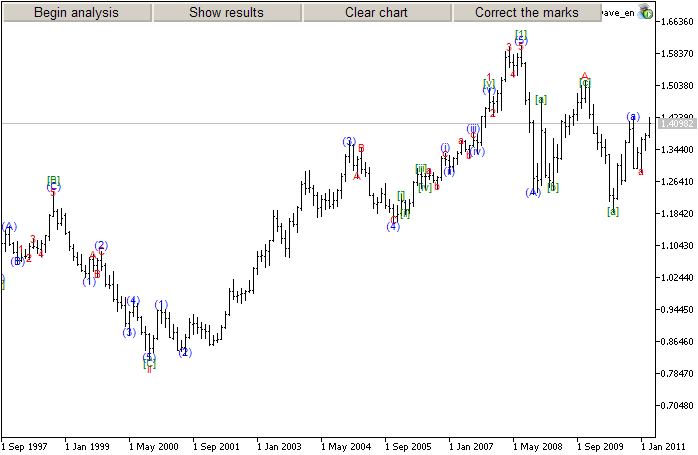
图 18. 以 MQL5 编写的自动分析程序识别的艾略特波浪
总结
本文回顾了艾略特波浪自动分析的一种算法。这个算法是以 MQL5 语言实施的。
程序有以上讨论的若干缺点,但提供了进一步改进的理由。我希望这个问题能够吸引艾略特波浪的拥趸,并且很快就会出现有关波浪自动分析的程序。